
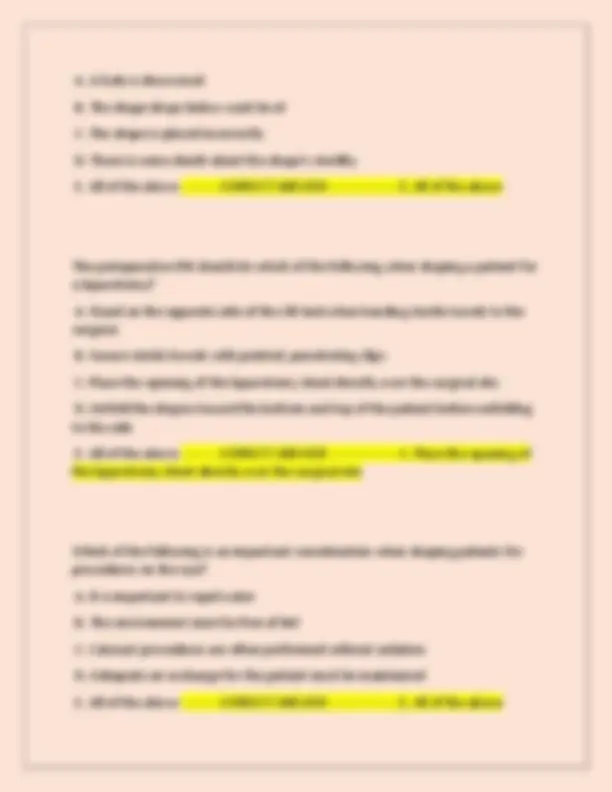
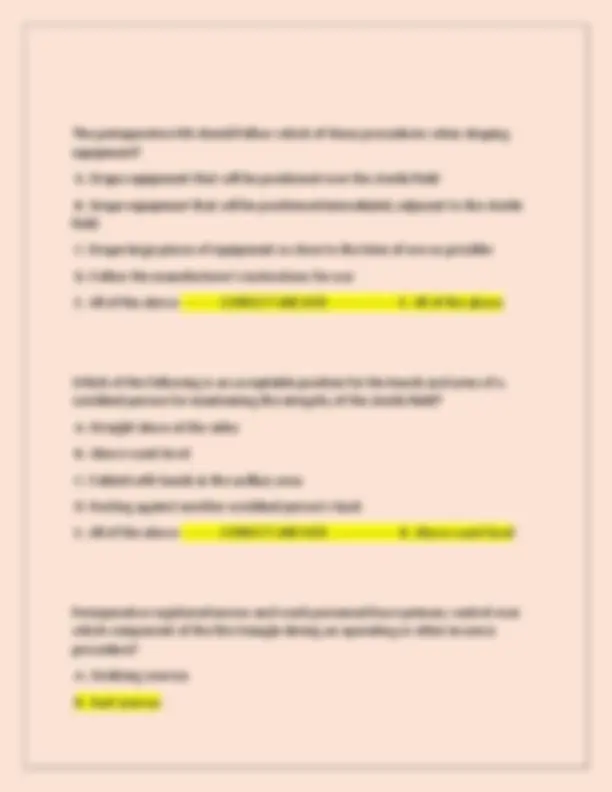
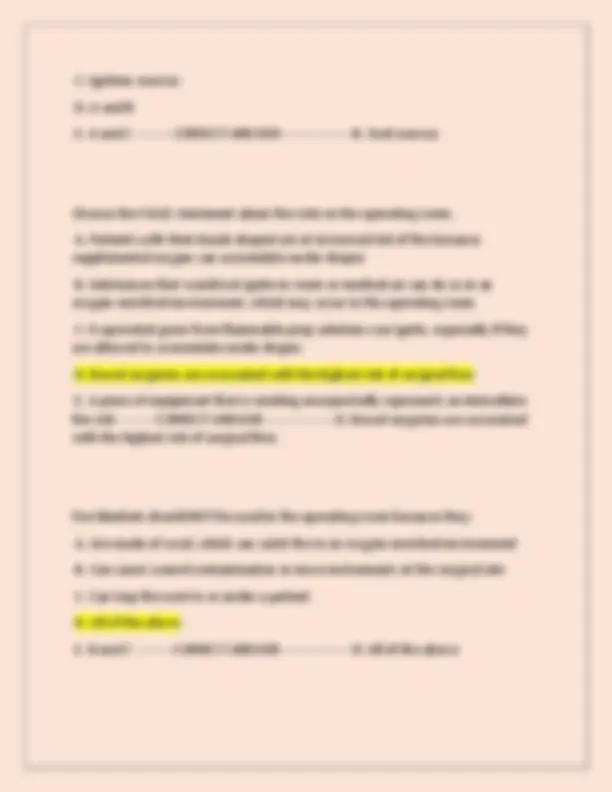
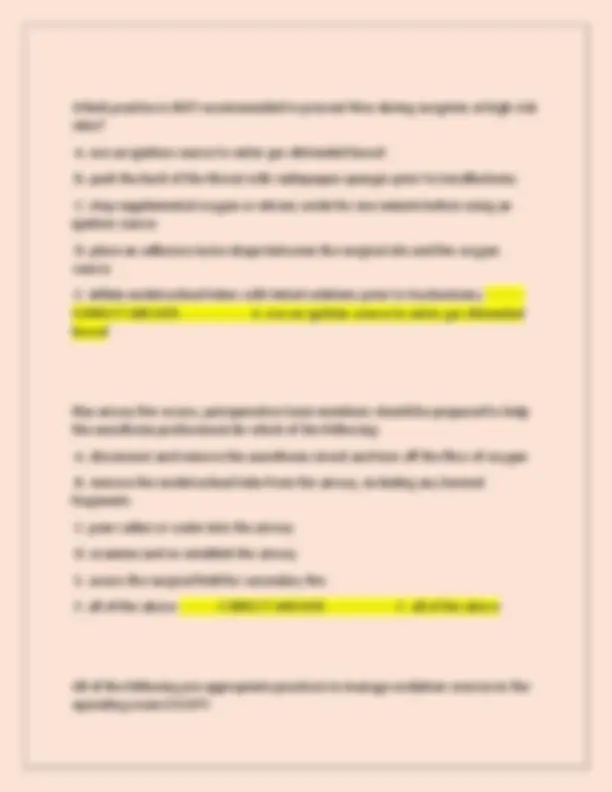
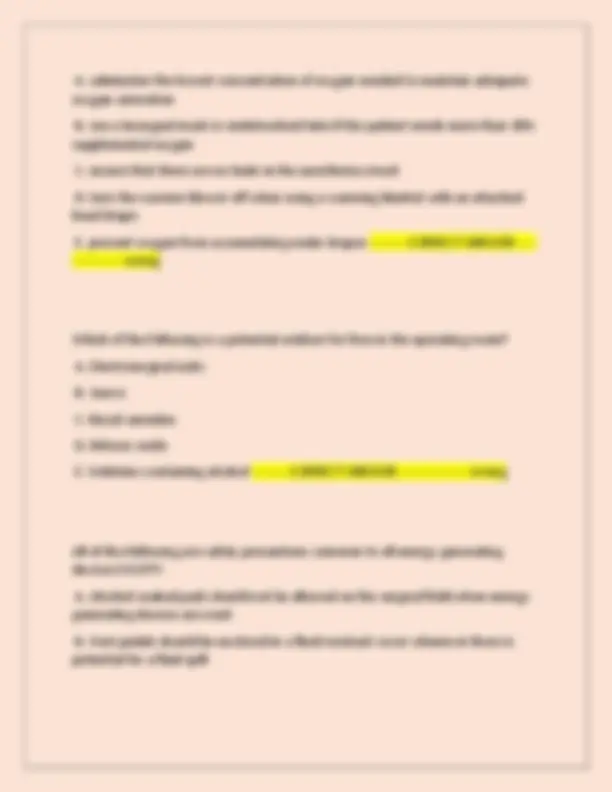
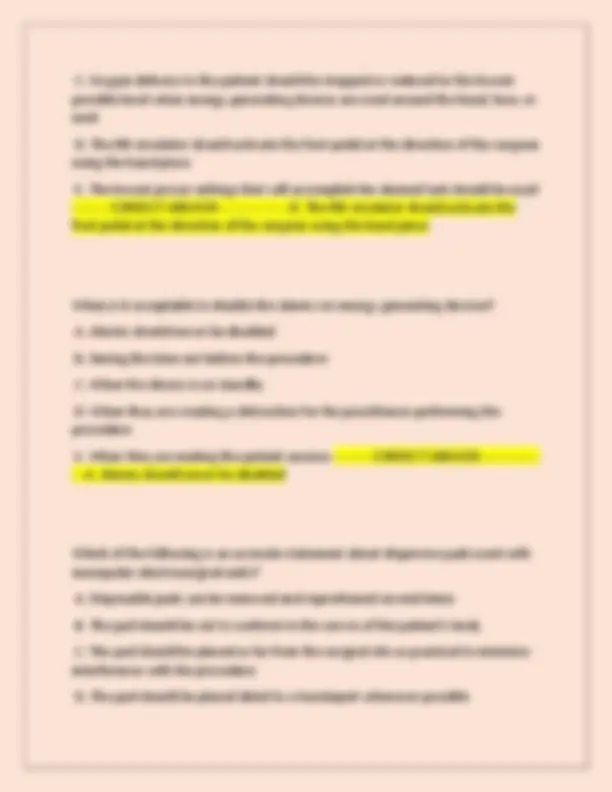
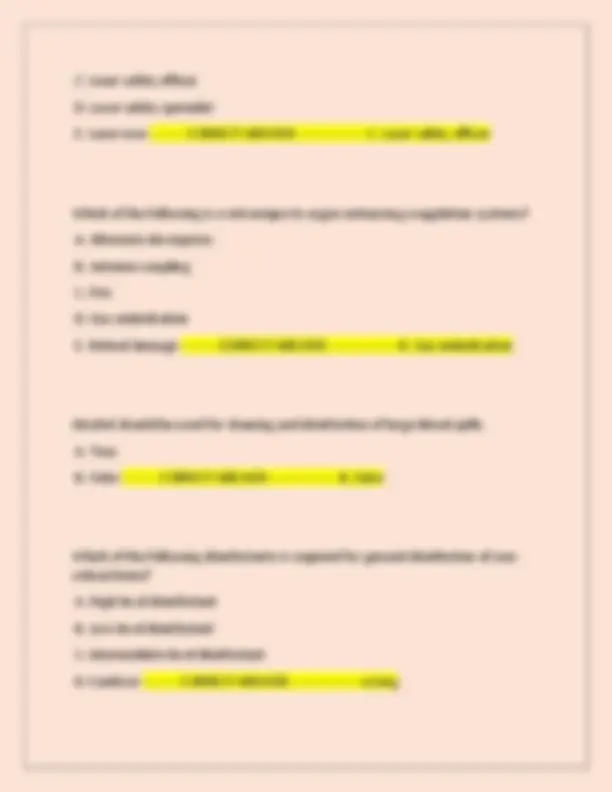
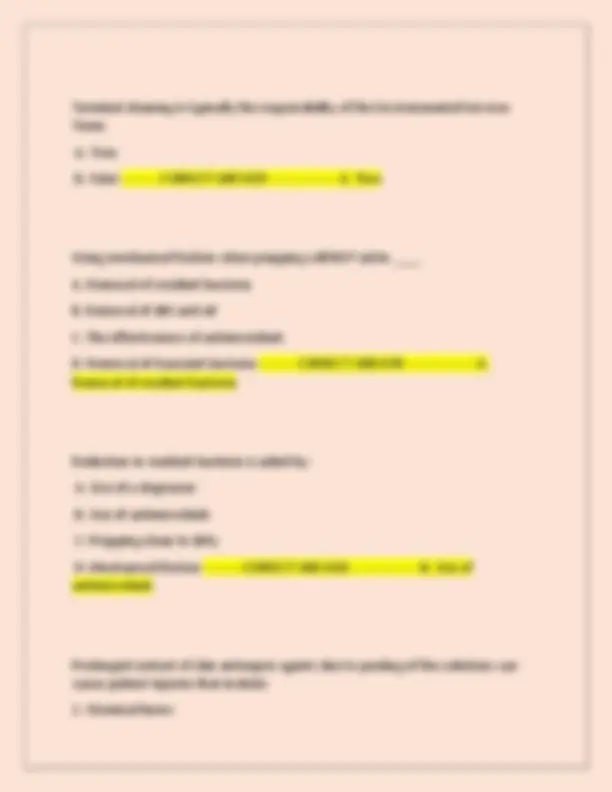
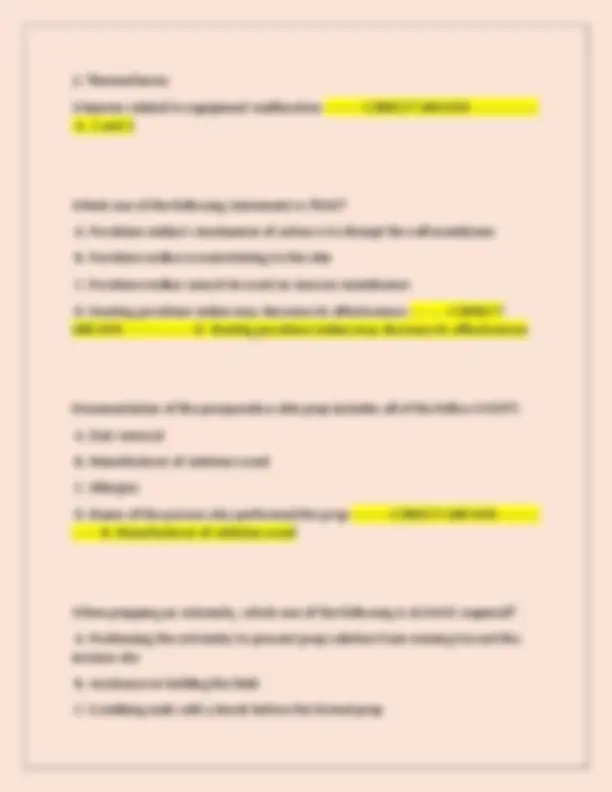
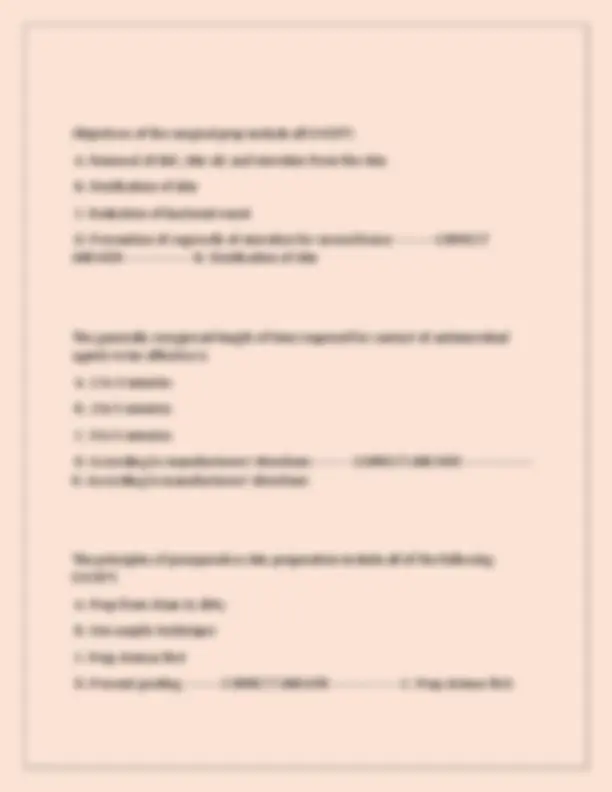
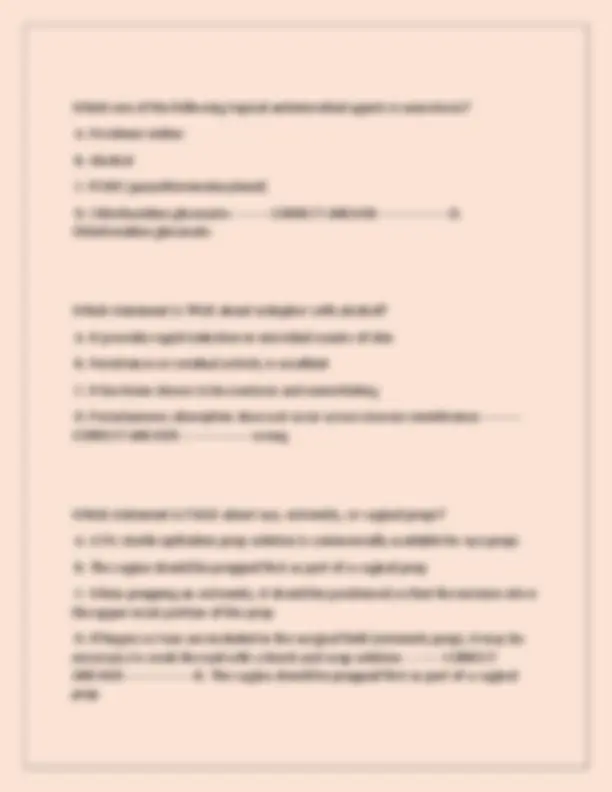
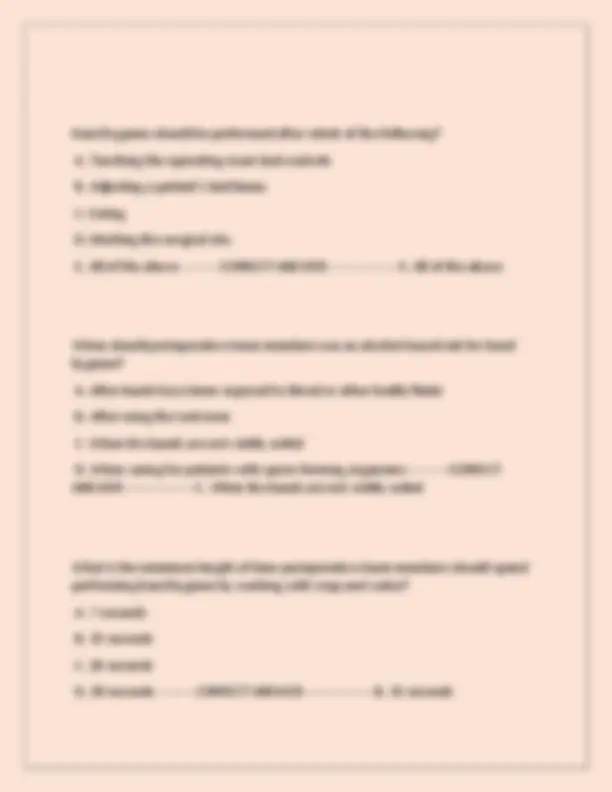
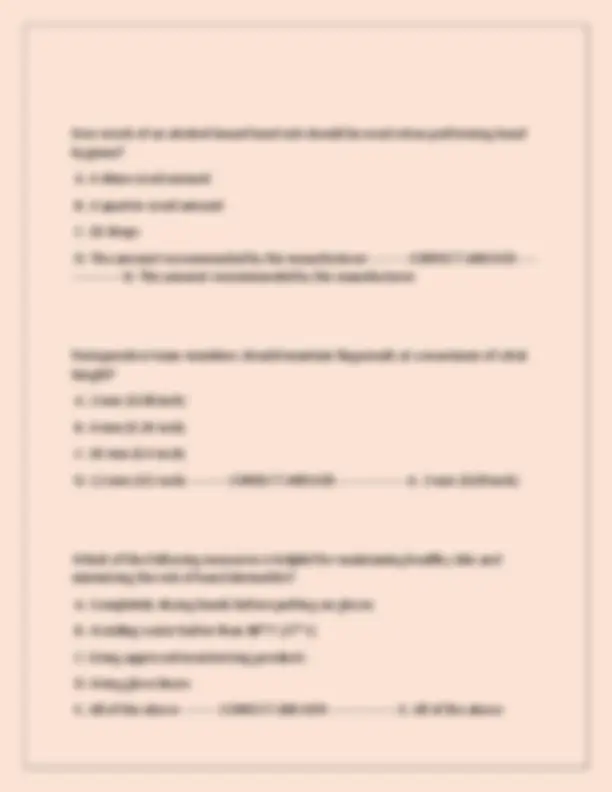
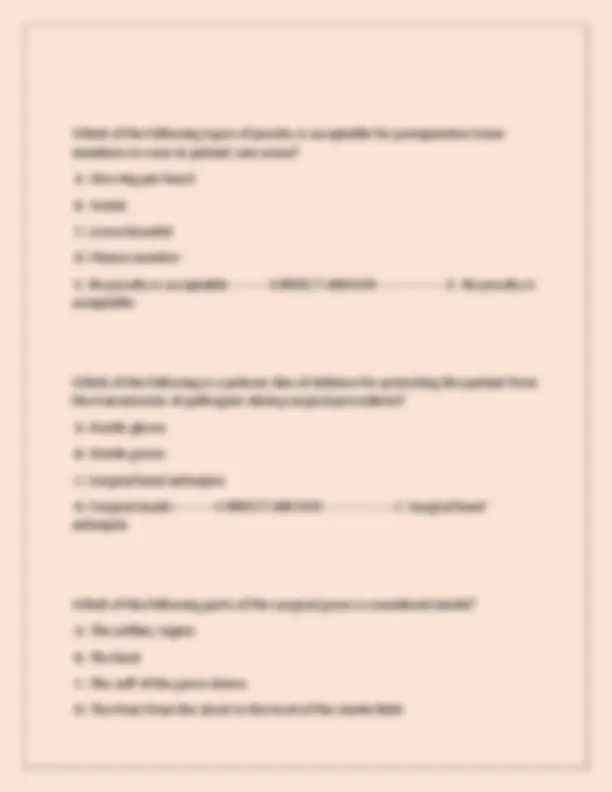
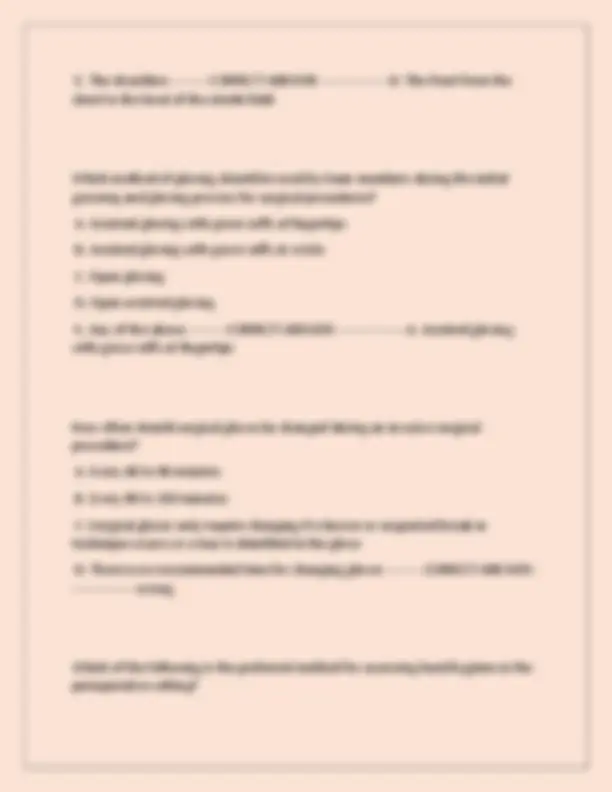
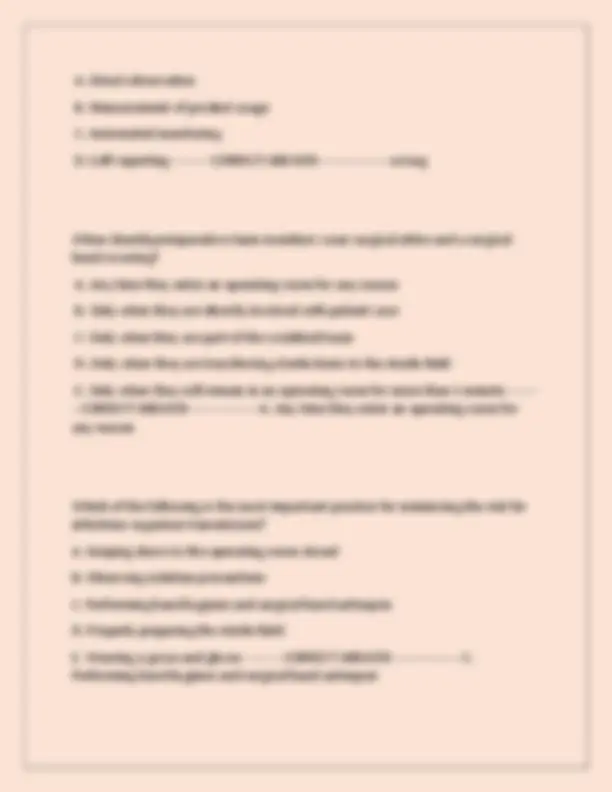
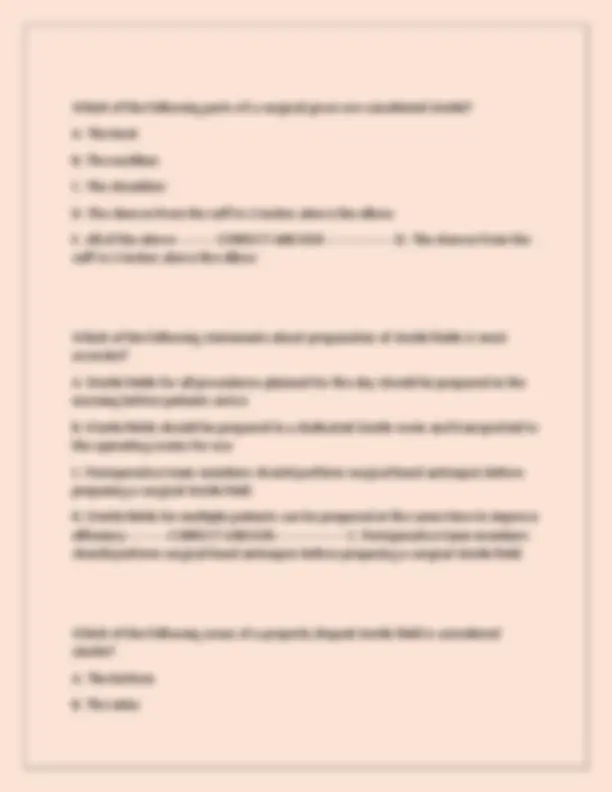
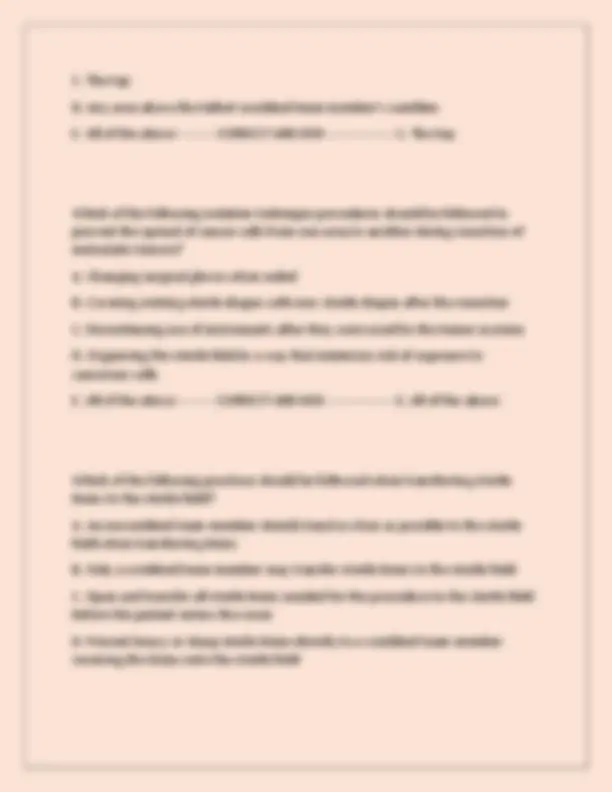
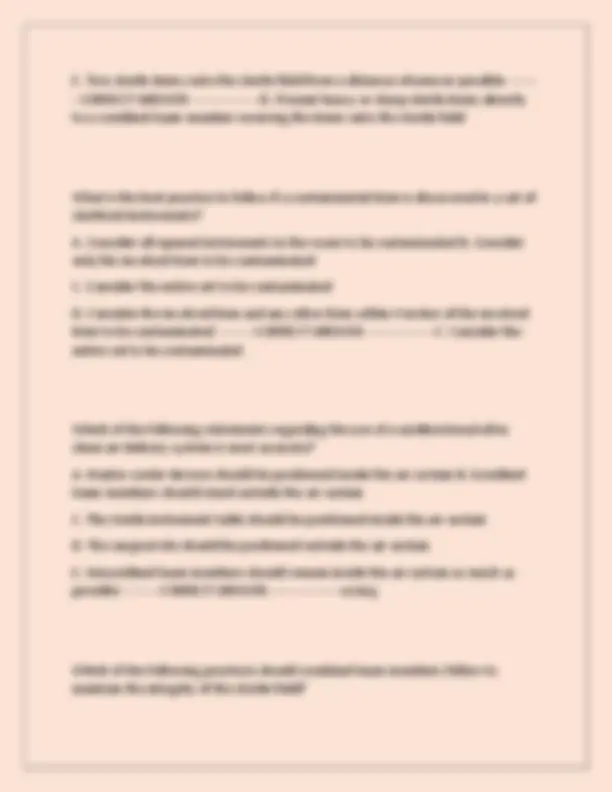
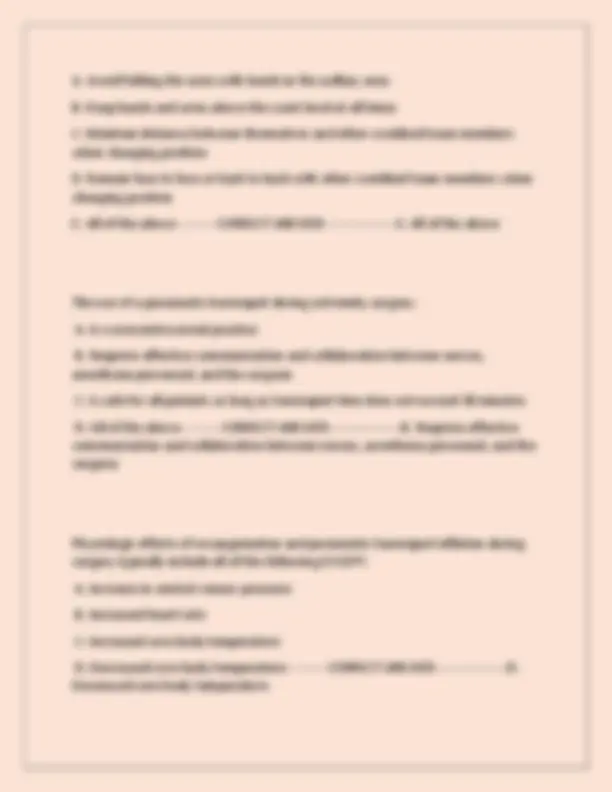
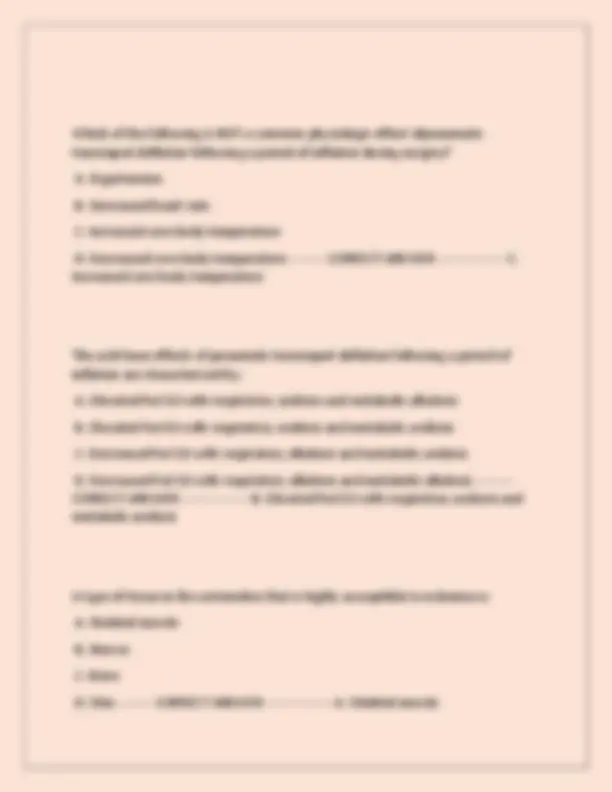
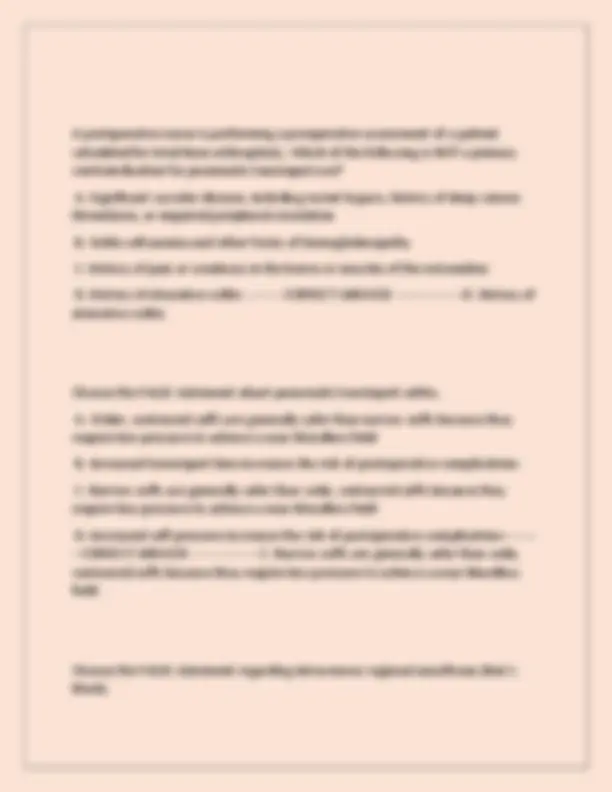
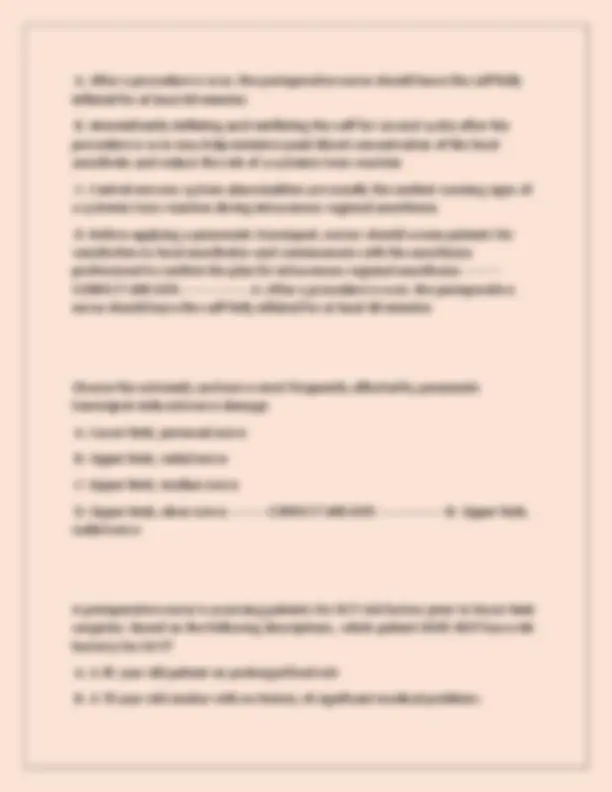
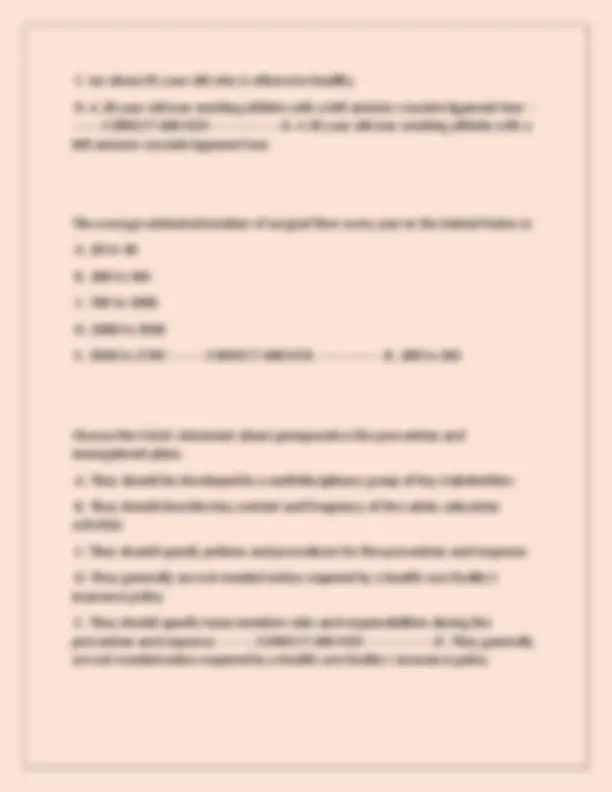
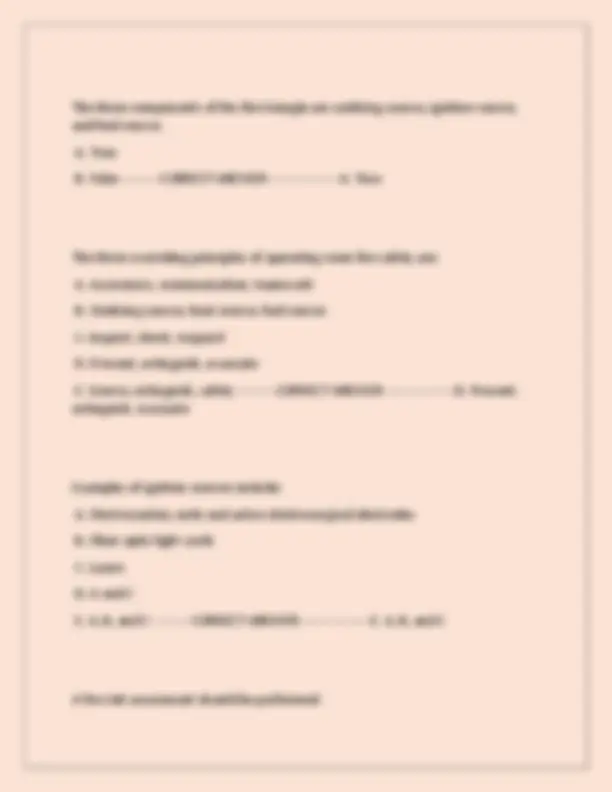
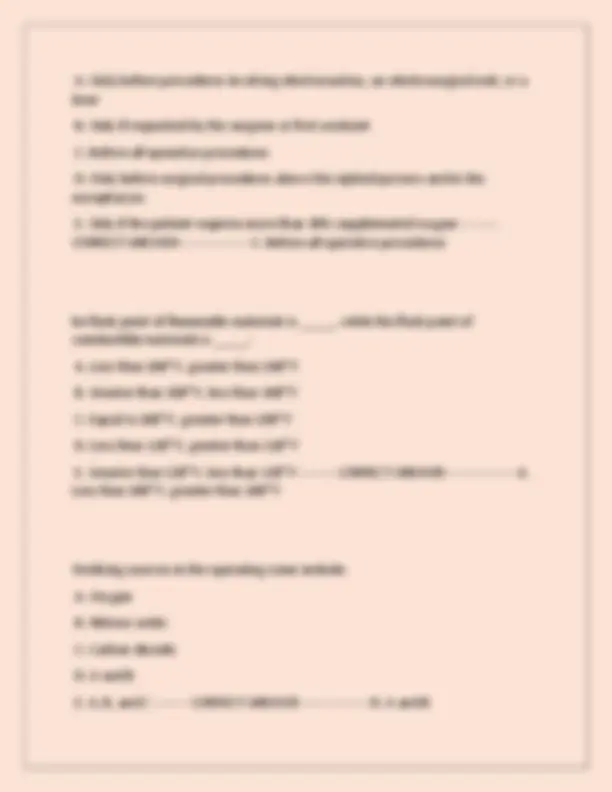
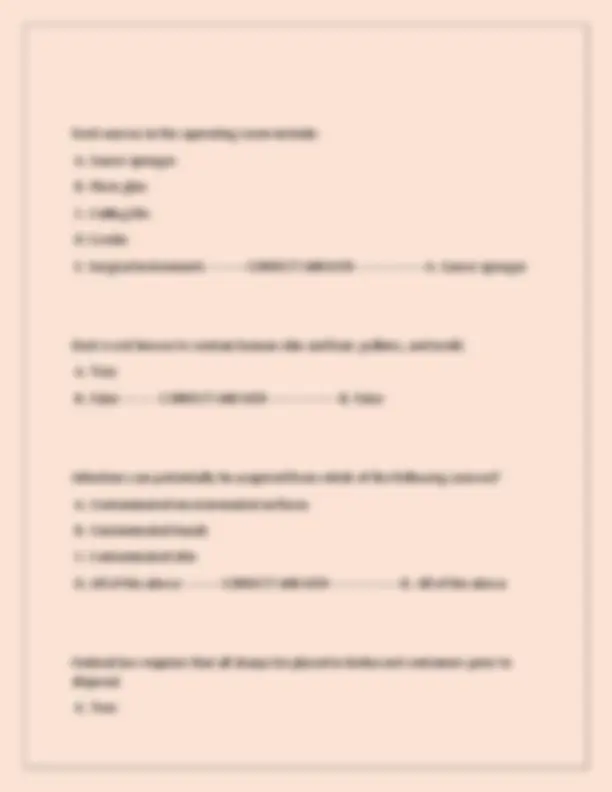
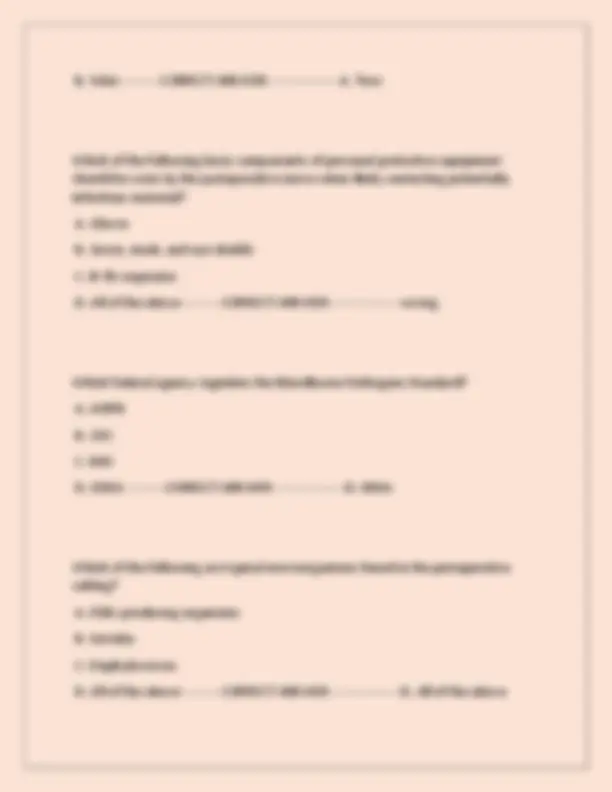
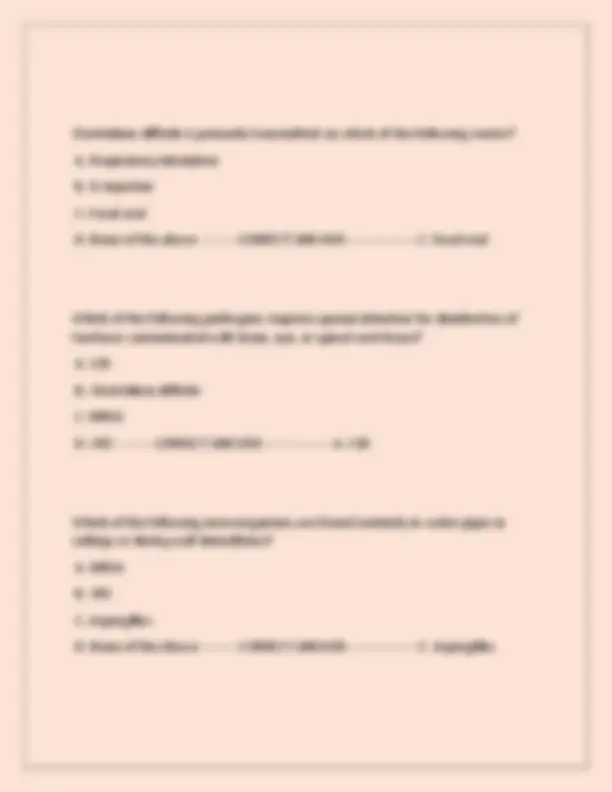

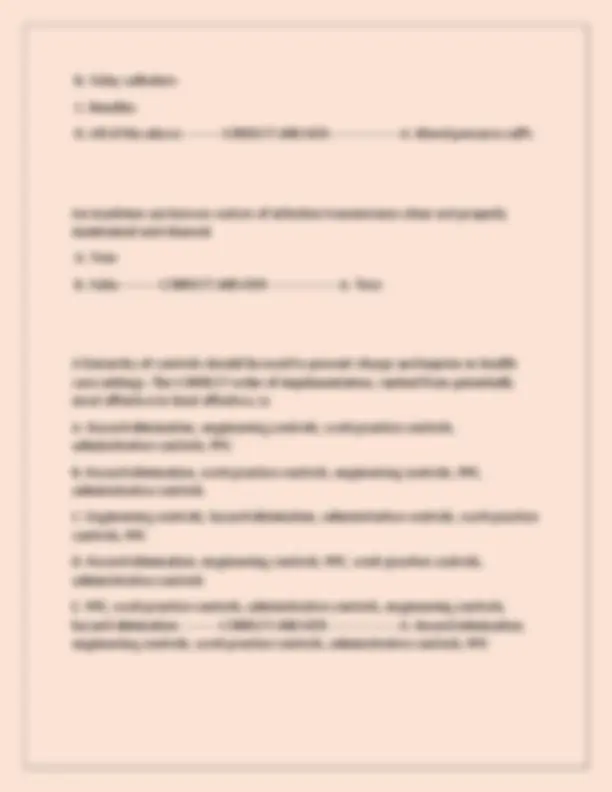
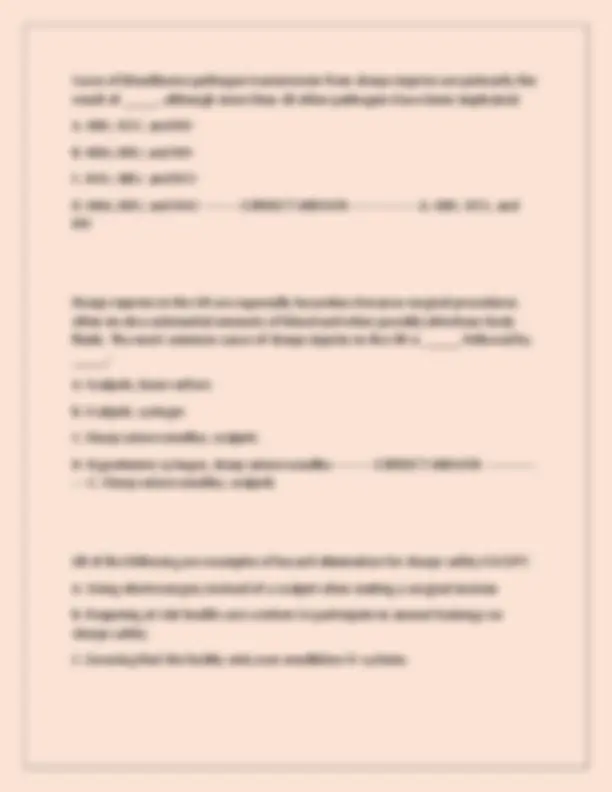
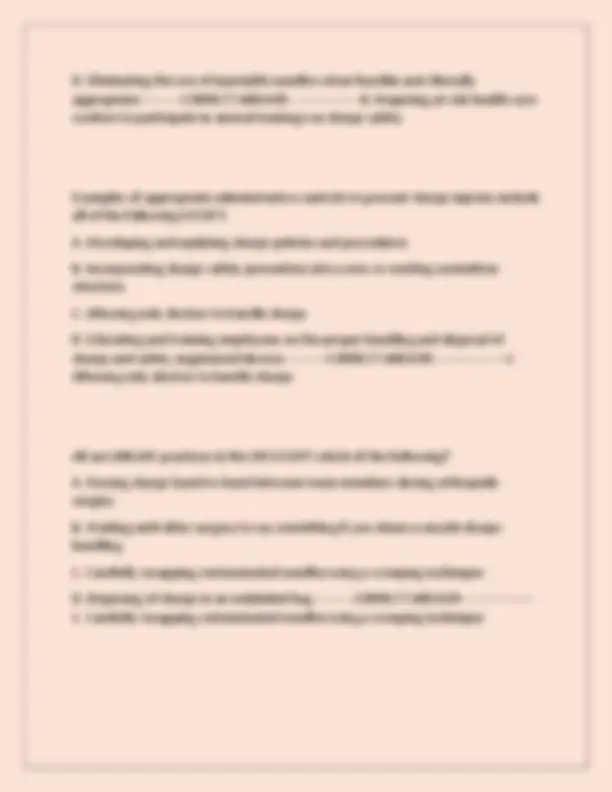
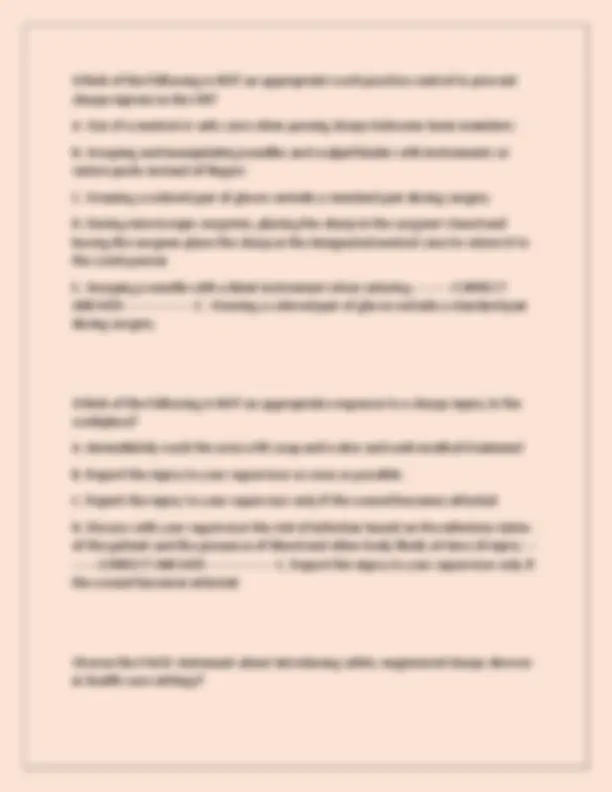
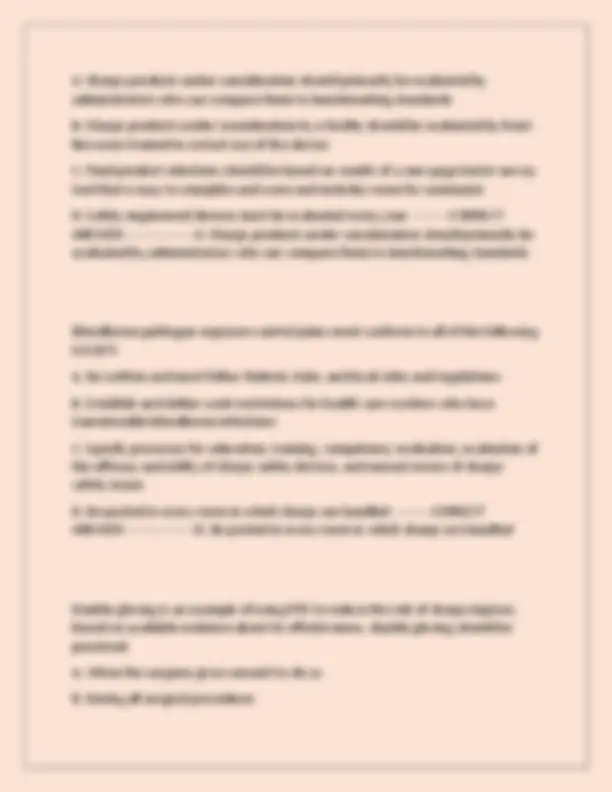
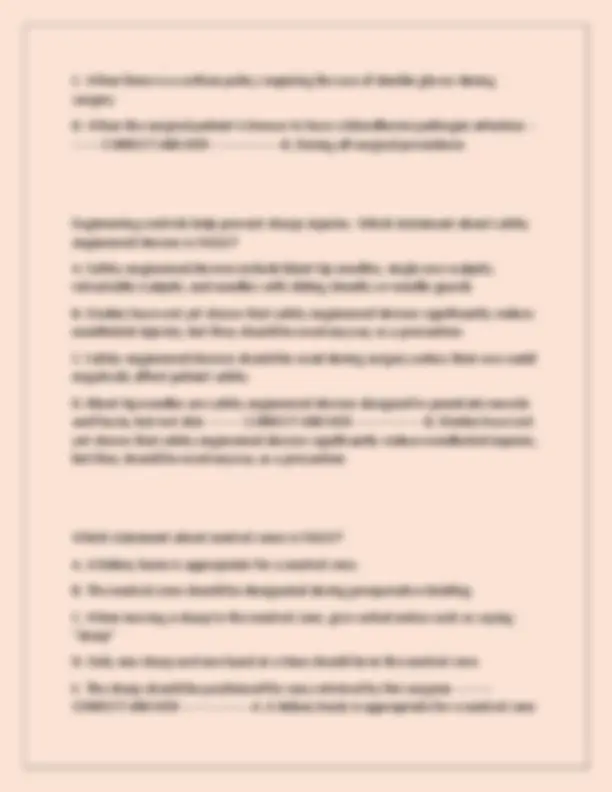
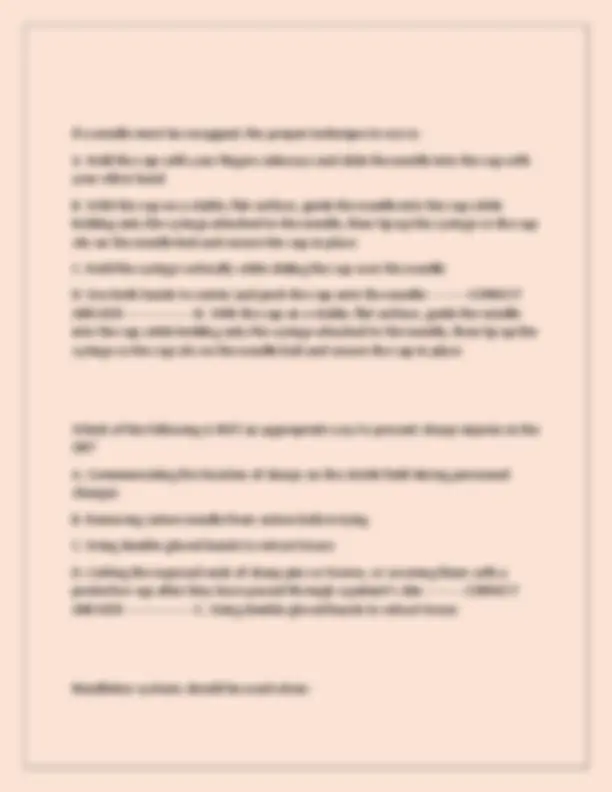
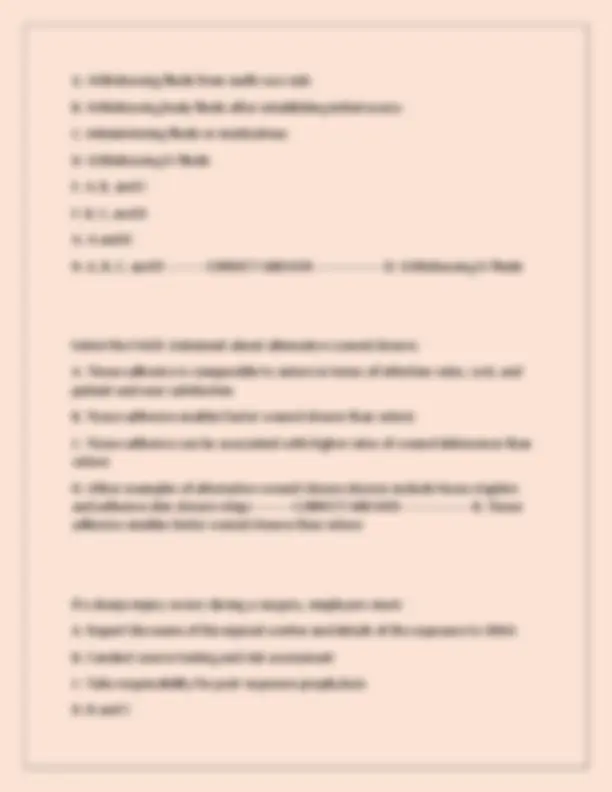
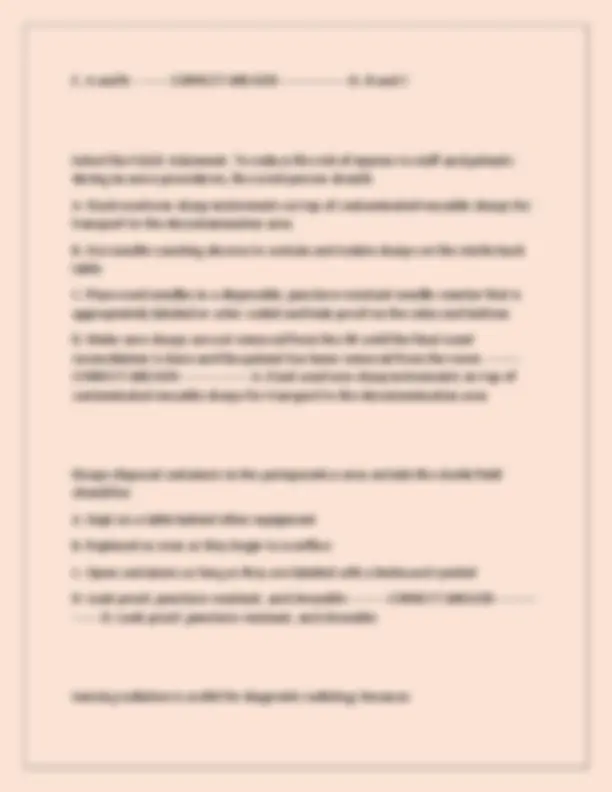
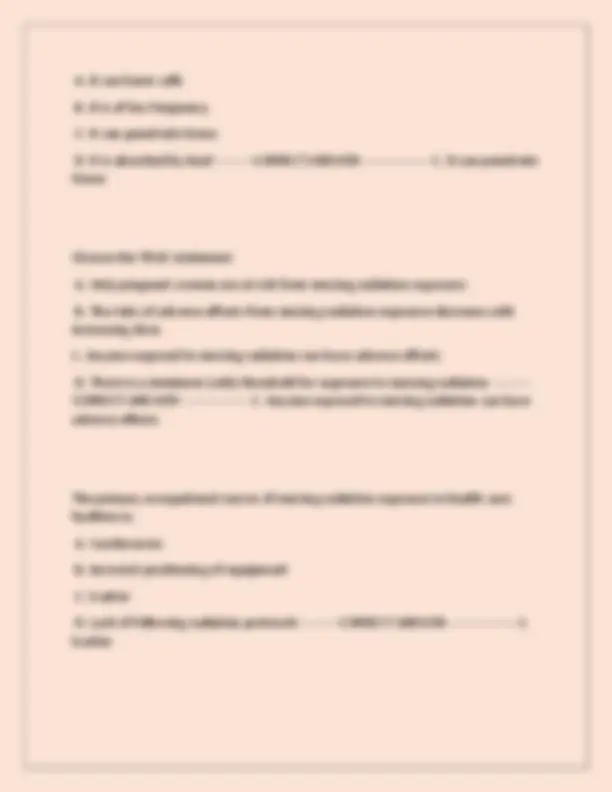
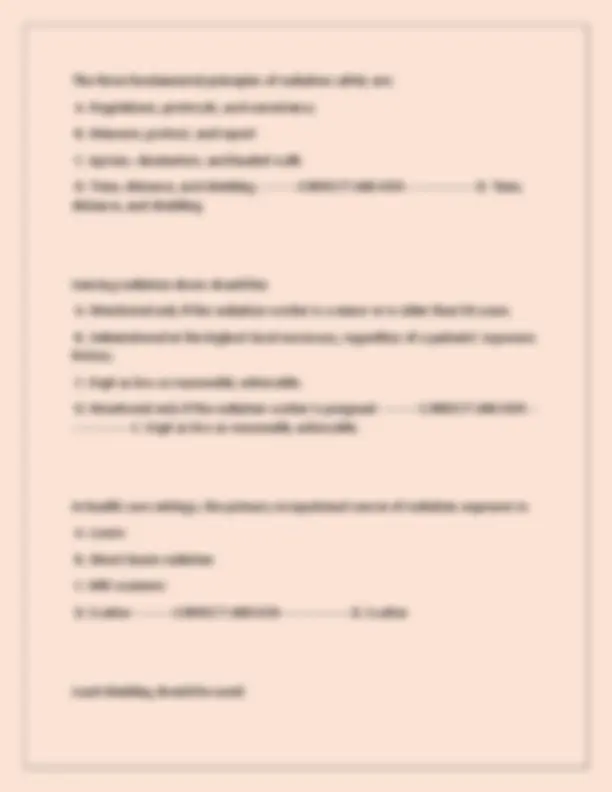
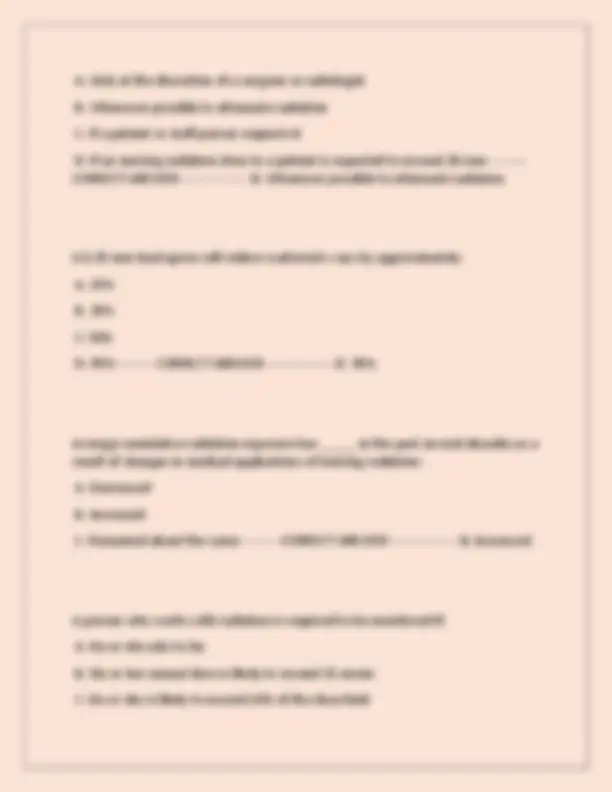

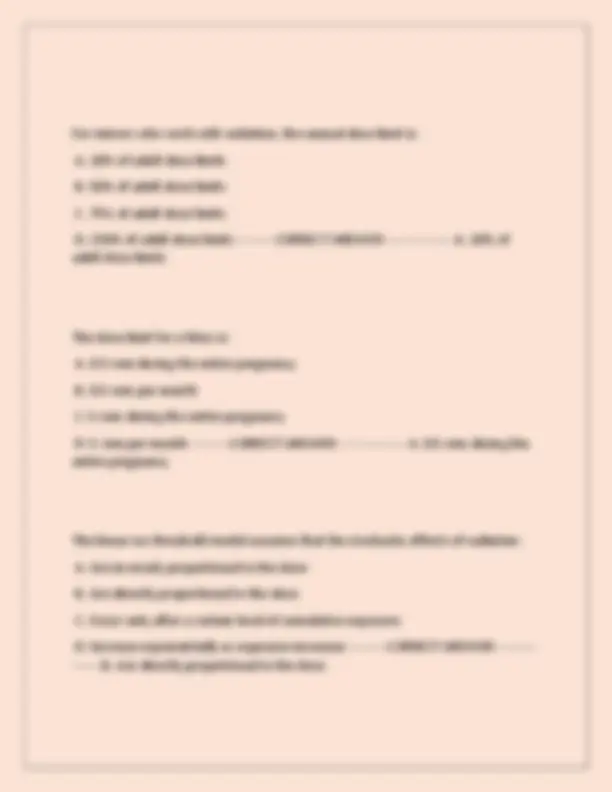
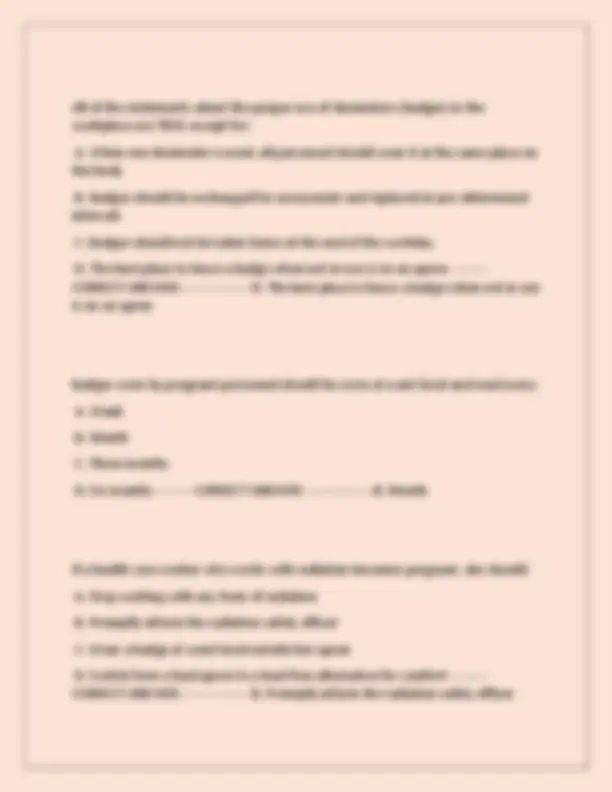
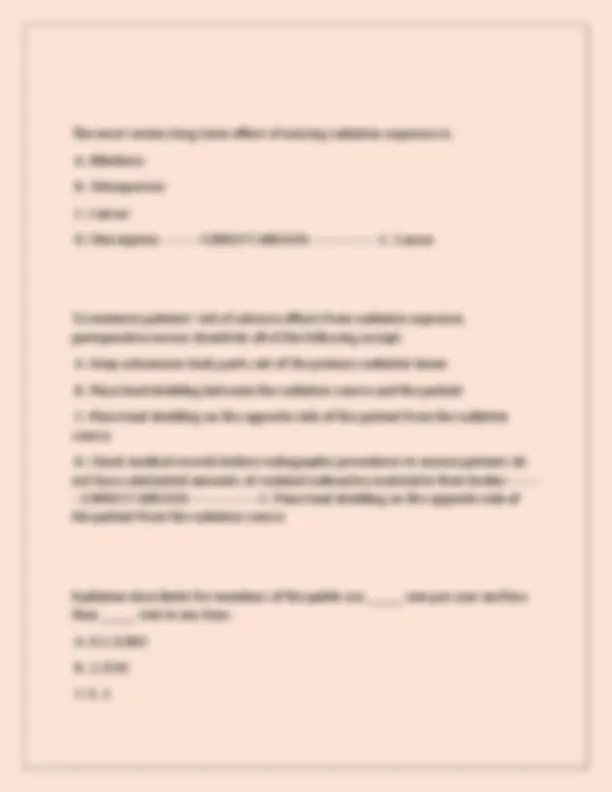
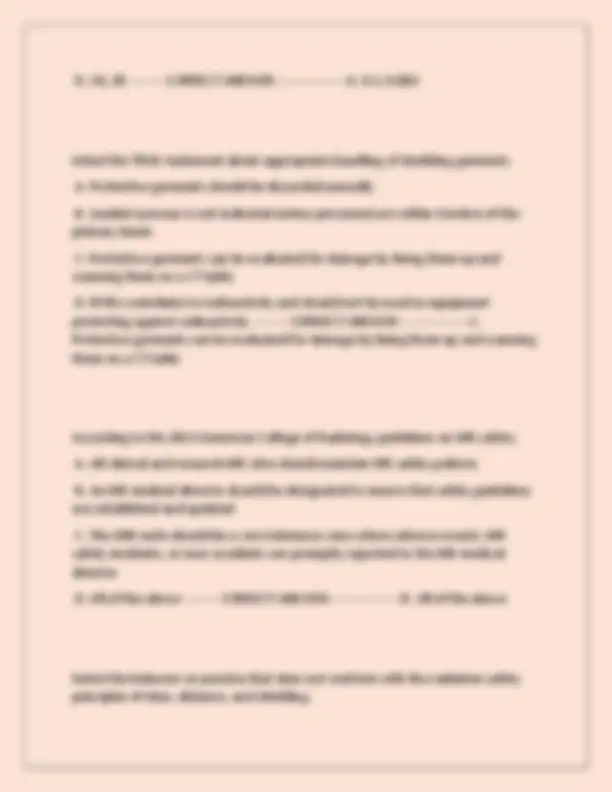
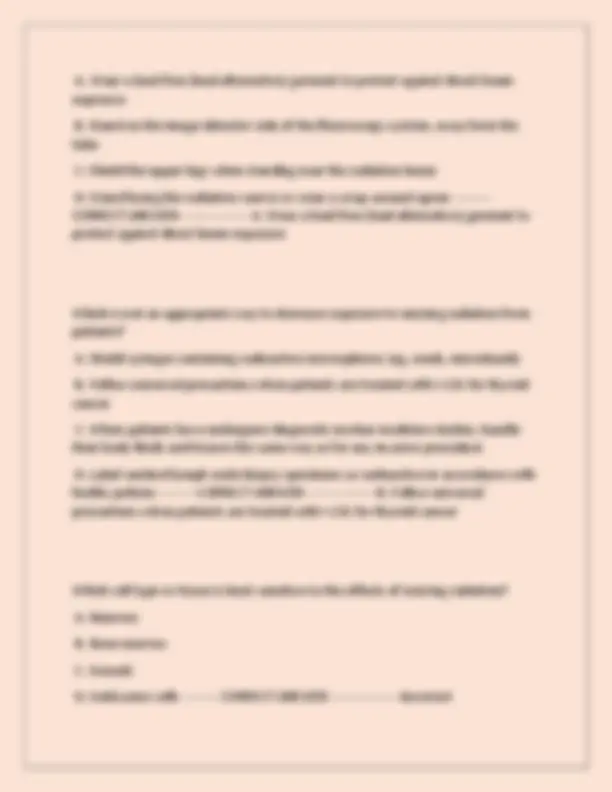
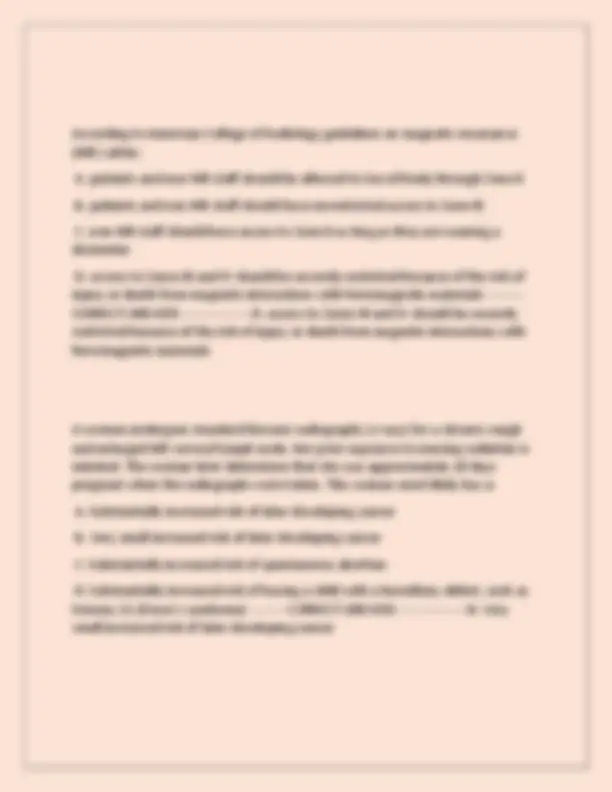
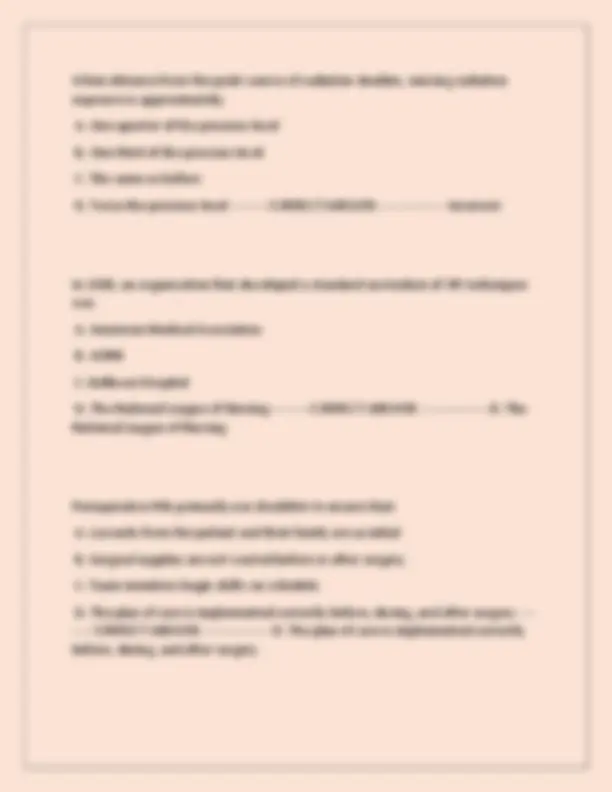
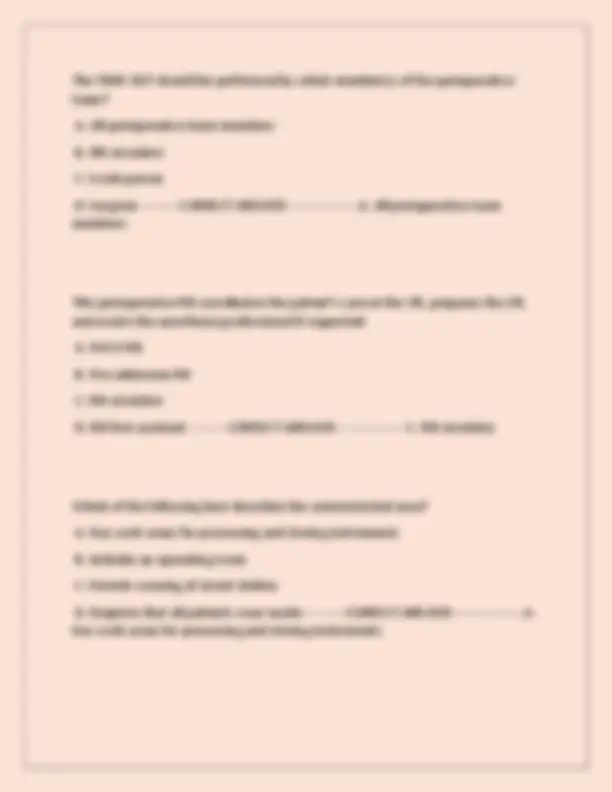
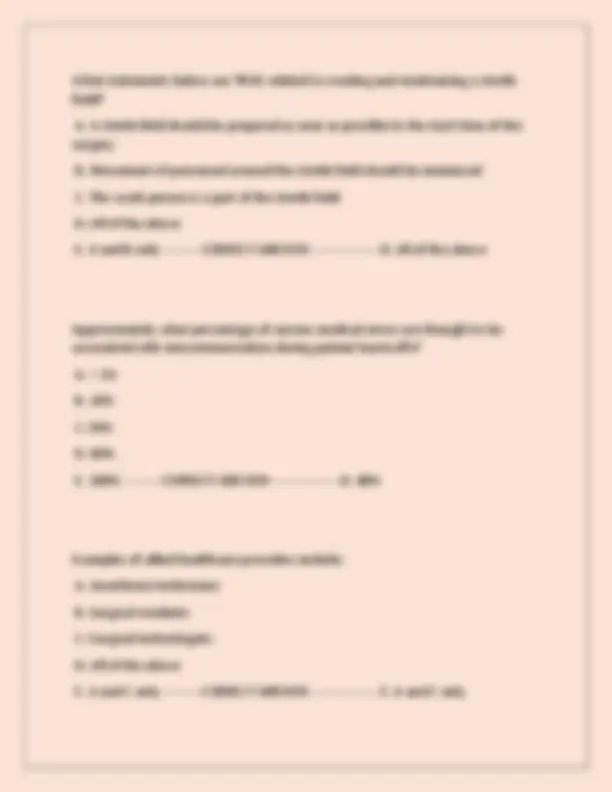
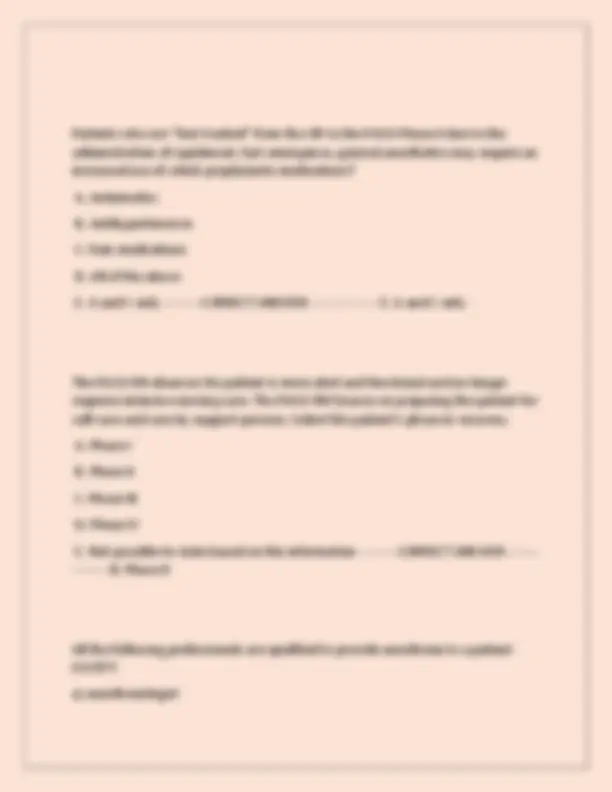
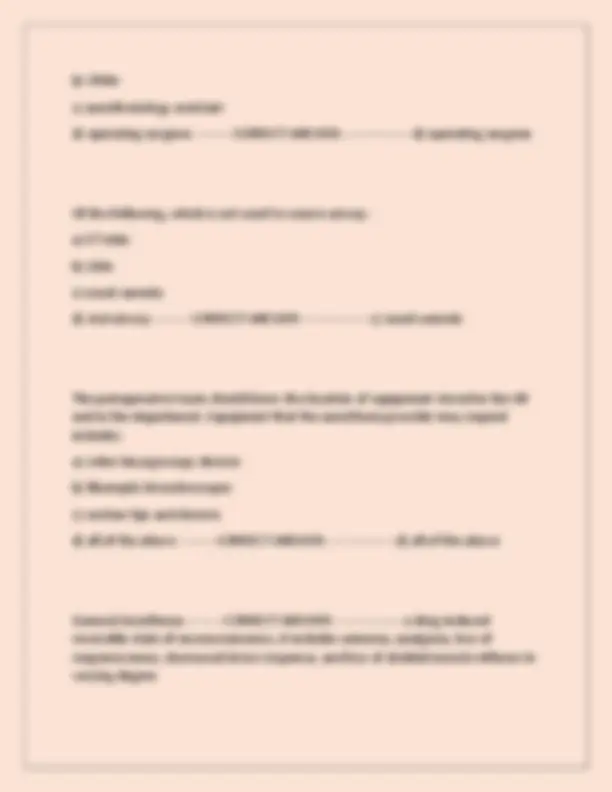
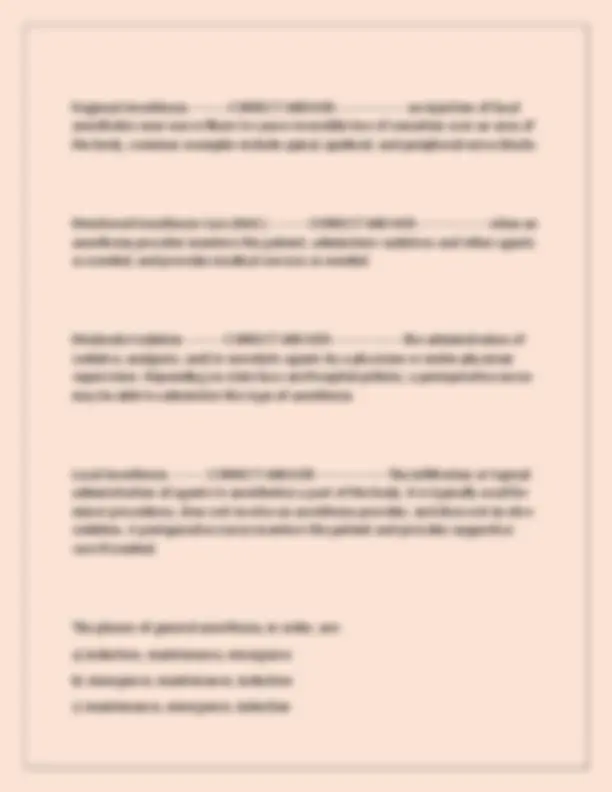




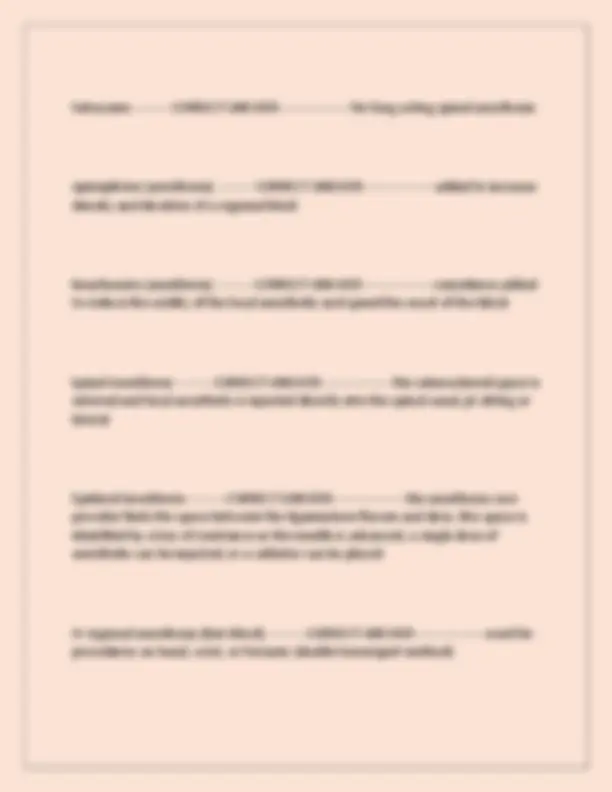
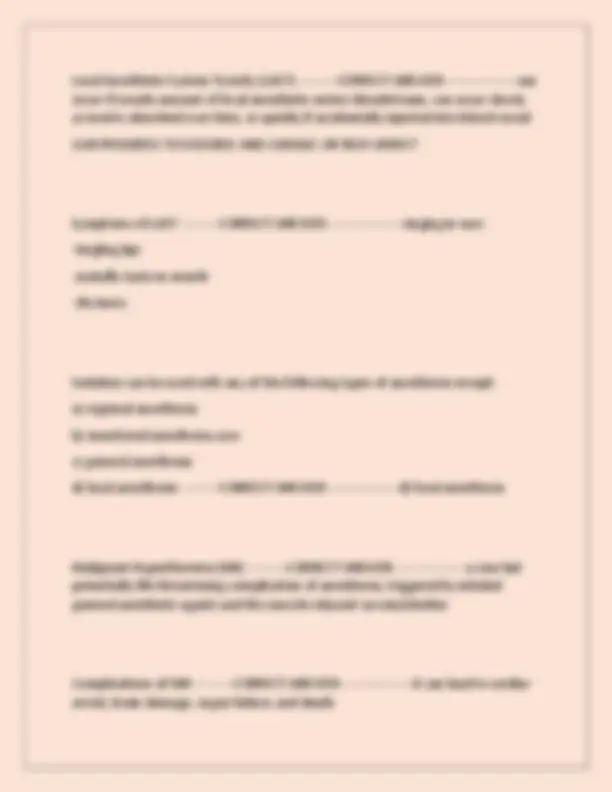
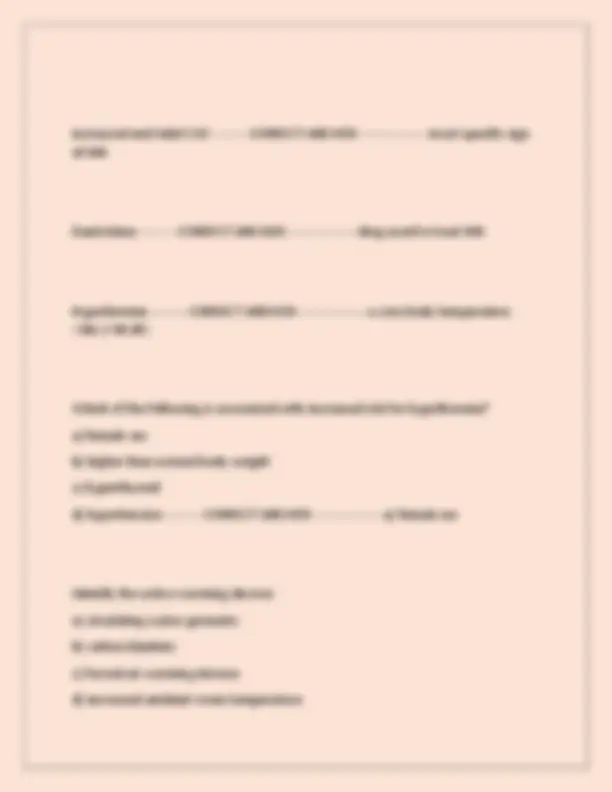
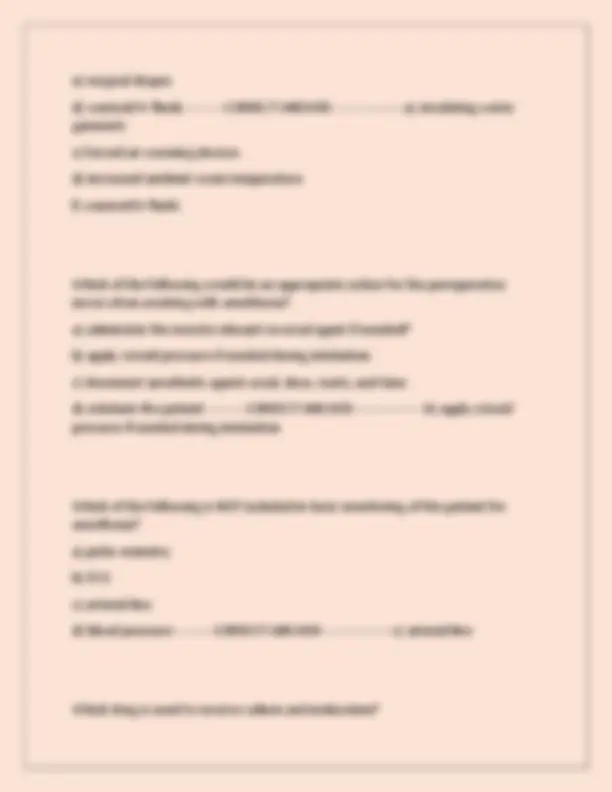
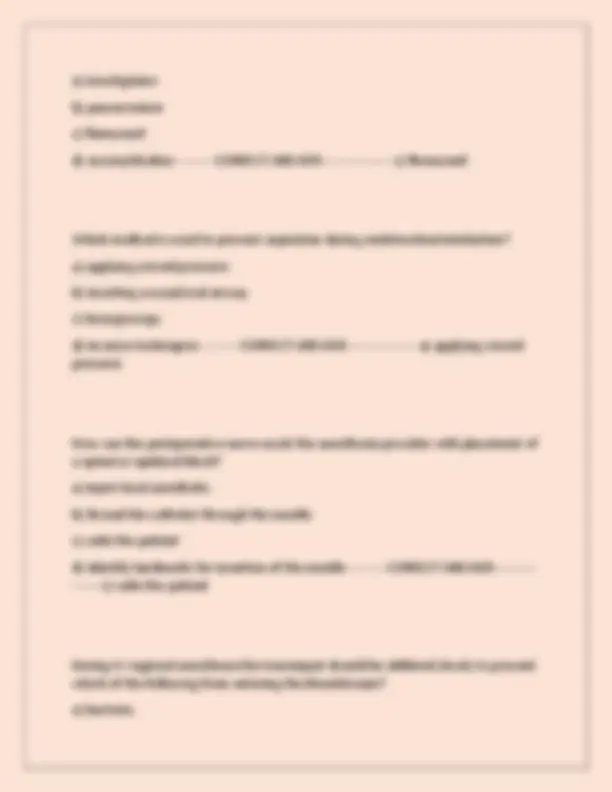
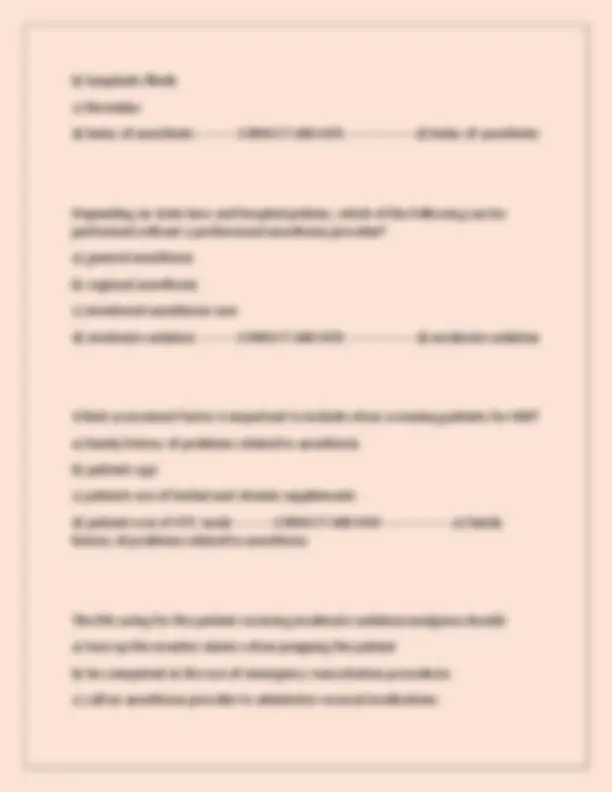

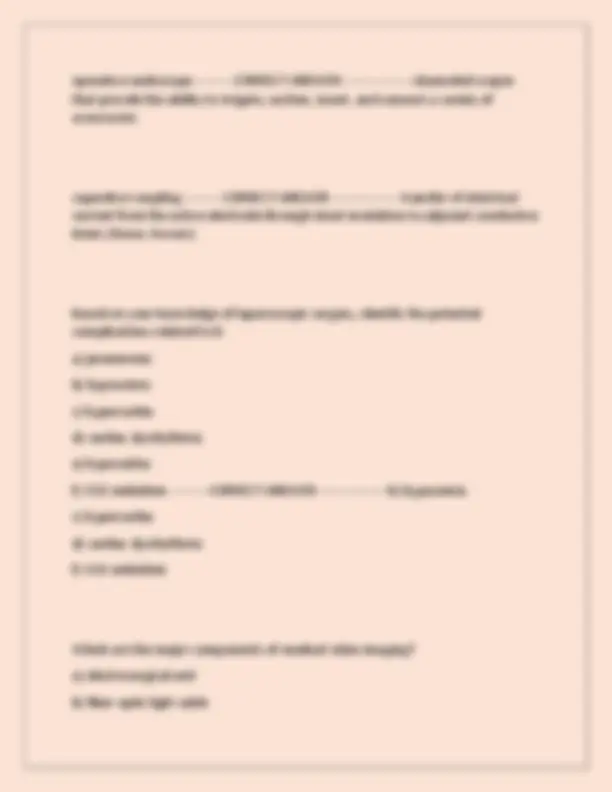
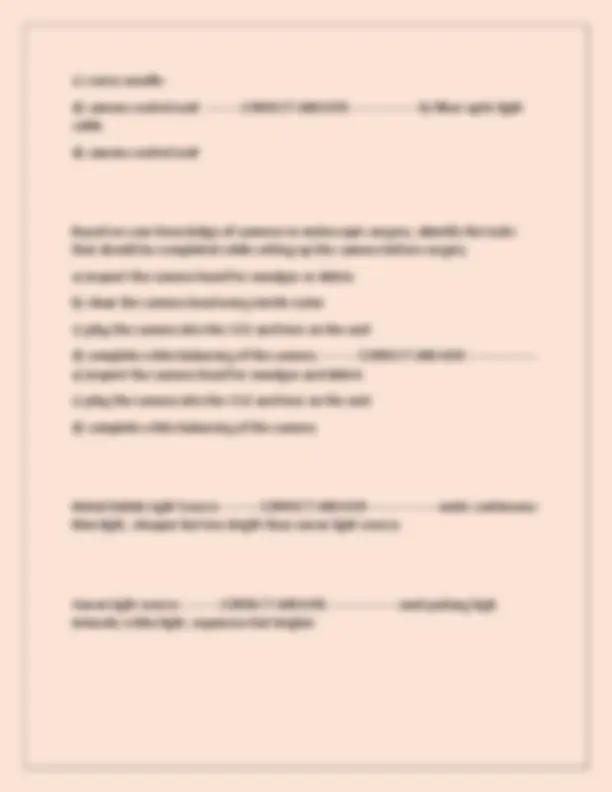
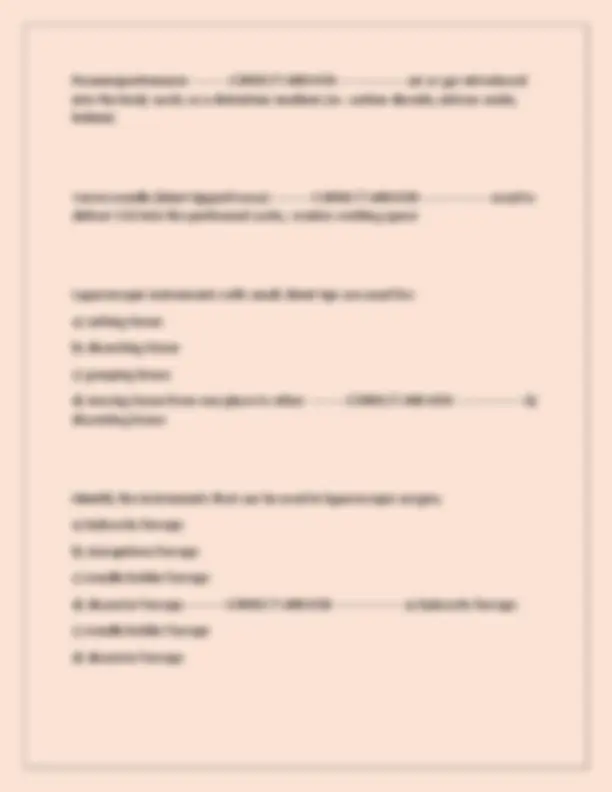
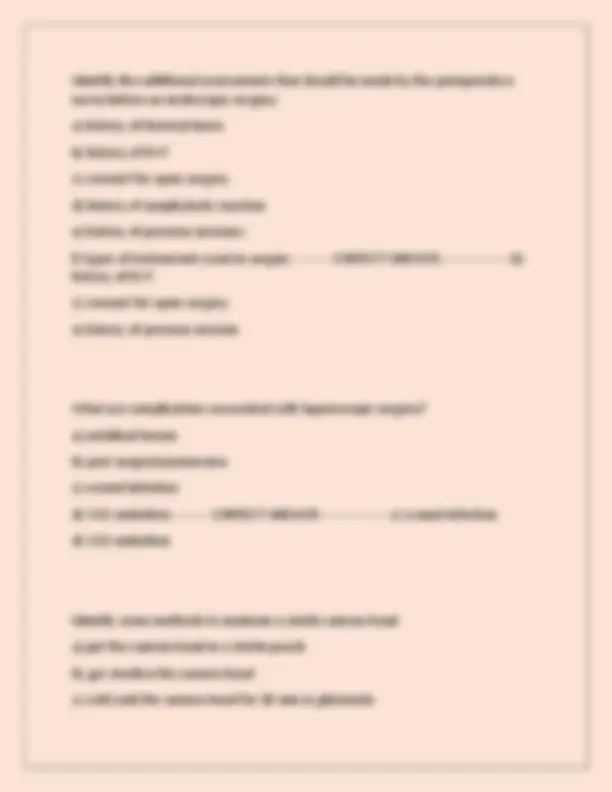
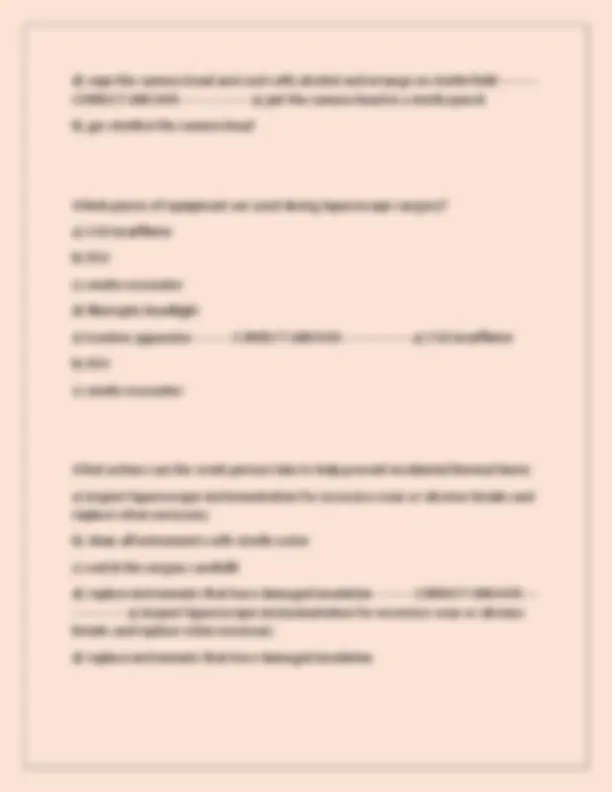
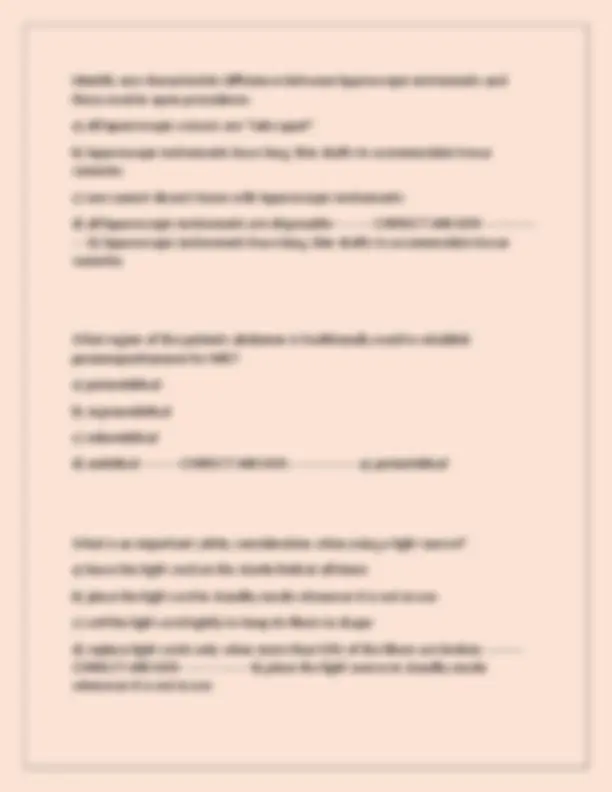
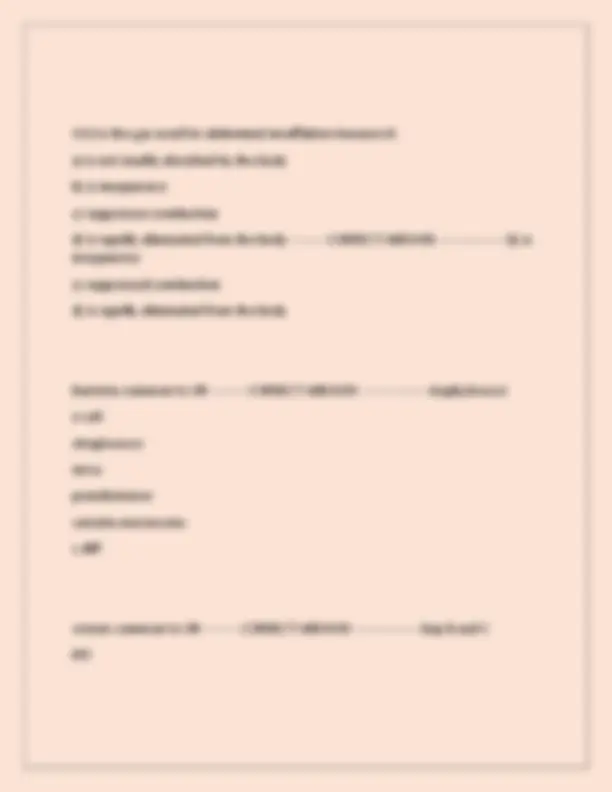
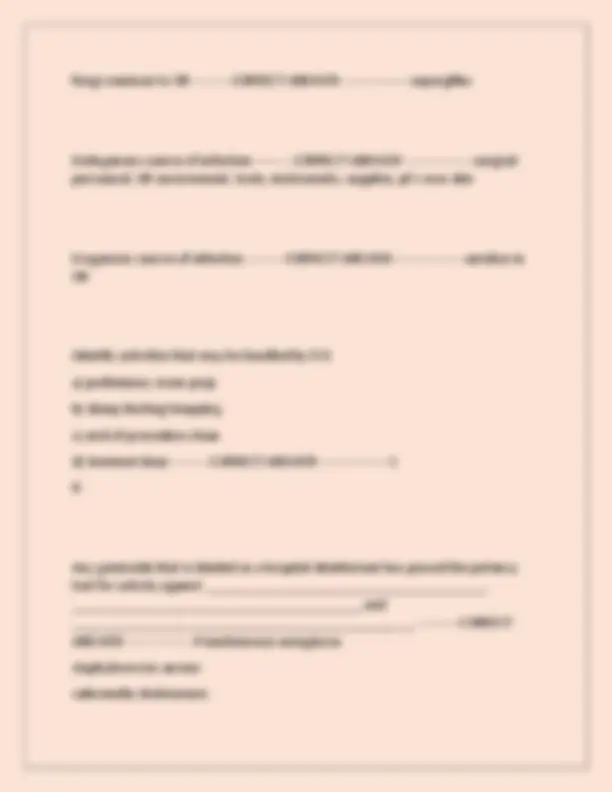
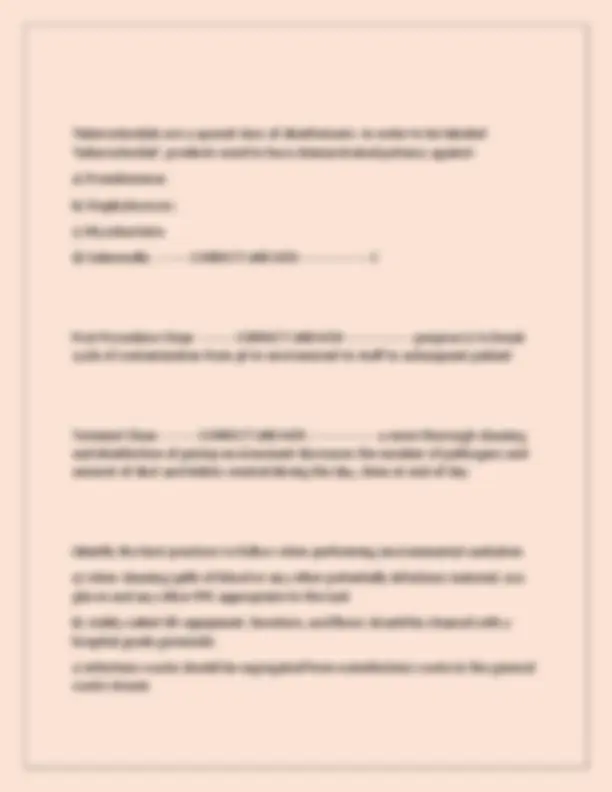

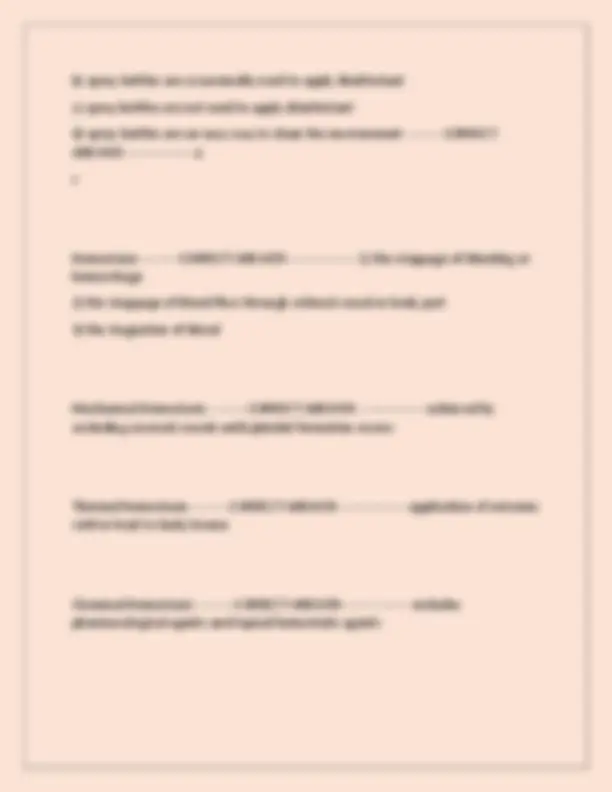
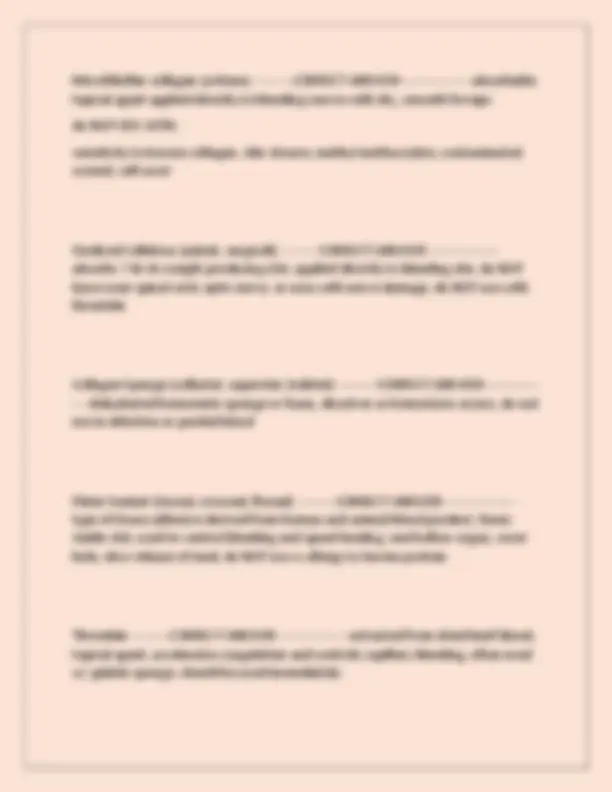

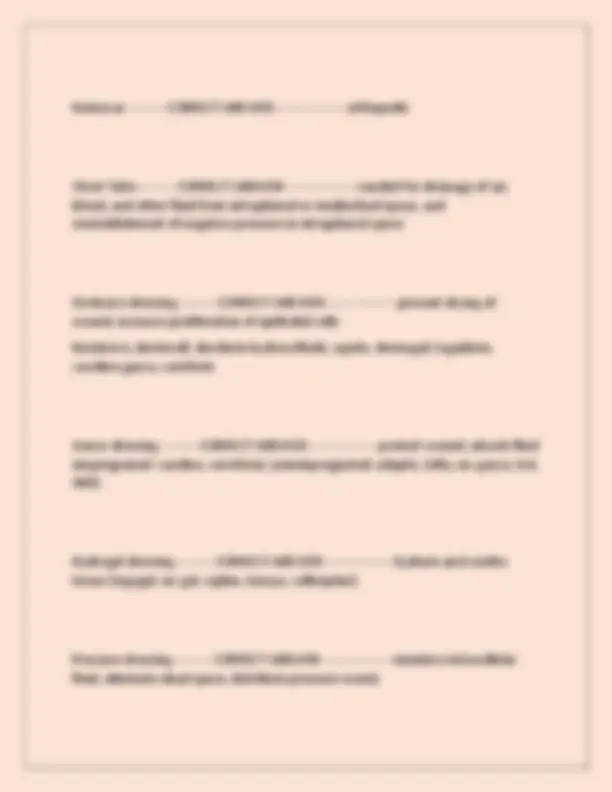

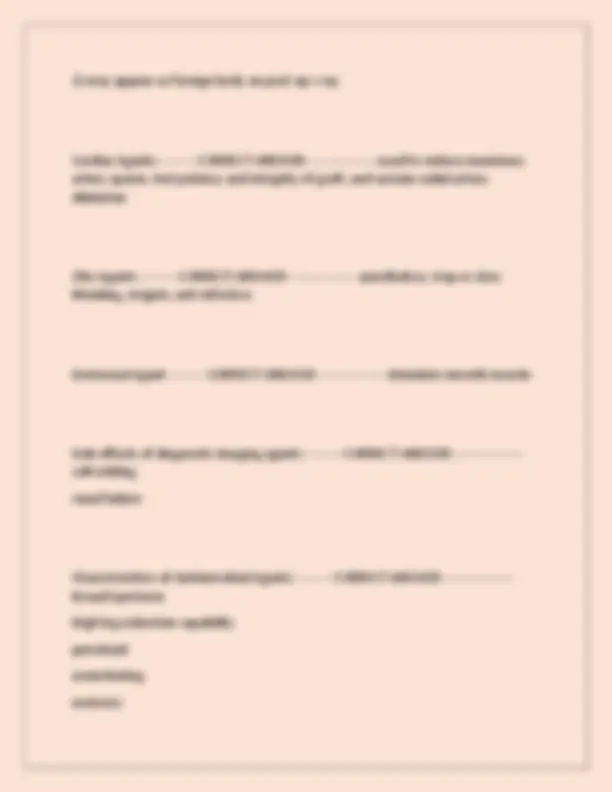
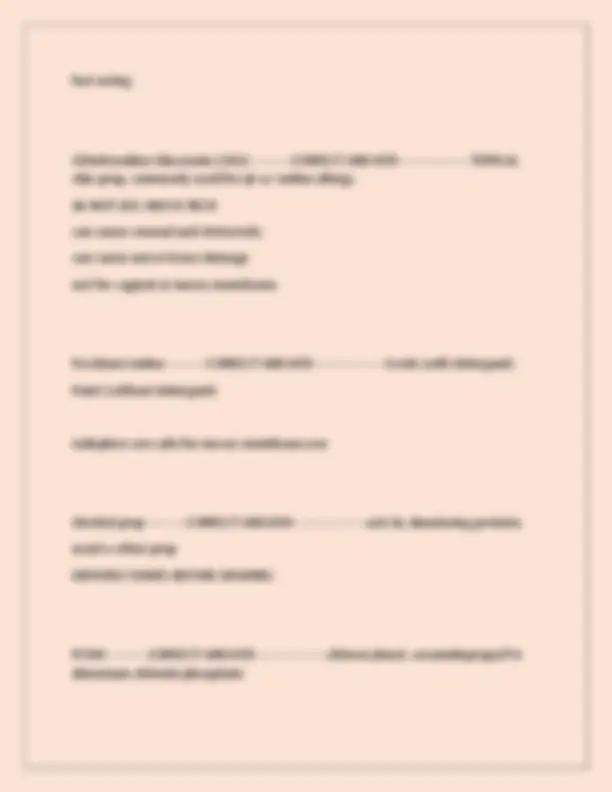
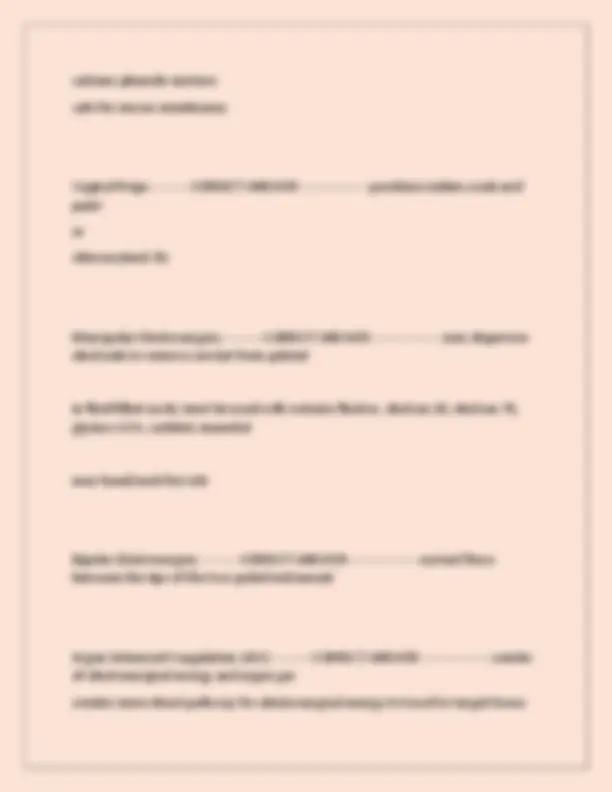
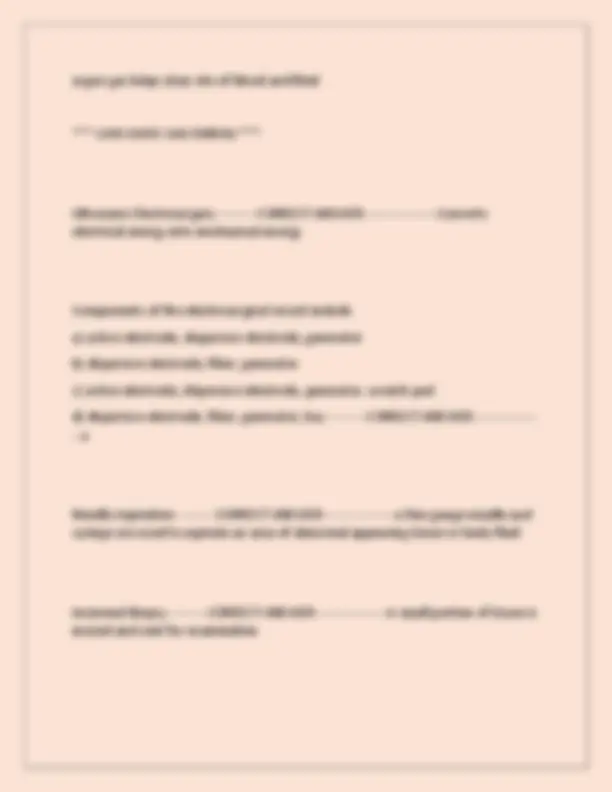
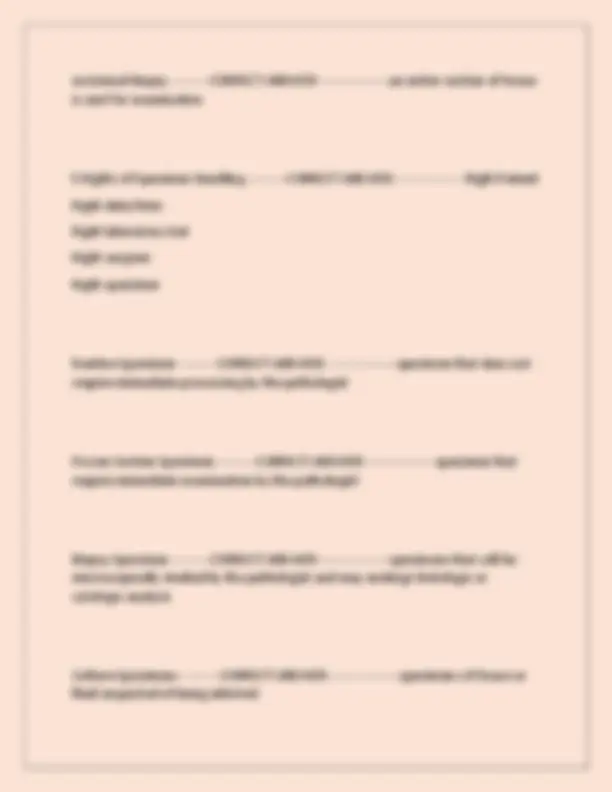








Study with the several resources on Docsity

Earn points by helping other students or get them with a premium plan


Prepare for your exams
Study with the several resources on Docsity

Earn points to download
Earn points by helping other students or get them with a premium plan
Community
Ask the community for help and clear up your study doubts
Discover the best universities in your country according to Docsity users
Free resources
Download our free guides on studying techniques, anxiety management strategies, and thesis advice from Docsity tutors
AORN PERIOP 101 Exam Test Bank 2025 | Complete Questions and Correct Answers | Graded A+ | Verified Answers | Brand New Version!
Typology: Exams
1 / 130

This page cannot be seen from the preview
Don't miss anything!





























































































Approximately what percentage of surgical patients develop a surgical site infection during hospitalization? A. 1% B. 5% C. 10% D. 15% E. 20% ---------CORRECT ANSWER-----------------B. 5% Which of the following terms is used to refer to seepage of fluid through a sterile material with subsequent bacterial penetration? A. Breakthrough B. Pierce through C. Punch through D. Strikethrough ---------CORRECT ANSWER-----------------D. Strikethrough Which of the following type of drape is designed to be tubular?
A. Fenestrated drape B. Flat sheet C. Stockinette D. Towel ---------CORRECT ANSWER-----------------C. Stockinette Which of the following is recommended when opening a sterile field in the perioperative setting? A. All sterile fields for all patients should be opened in a designated central sterile area and transported to the OR for use B. Cables and tubing should be secured with non-perforating devices C. Drapes should be shaken after opening and before placement to remove dust D. When draping a patient, the RN should drape the peripheral areas first and move inward toward the surgical site ---------CORRECT ANSWER-----------------B. Cables and tubing should be secured with non-perforating devices Which surfaces of the sterile drape are considered sterile? A. Top only B. Top and bottom but not sides C. Top and sides but not bottom D. Top, bottom, and sides E. Bottom and sides ---------CORRECT ANSWER-----------------A. Top only Drapes are considered contaminated under which of the following conditions?
The perioperative RN should follow which of these procedures when draping equipment? A. Drape equipment that will be positioned over the sterile field B. Drape equipment that will be positioned immediately adjacent to the sterile field C. Drape large pieces of equipment as close to the time of use as possible D. Follow the manufacturer's instructions for use E. All of the above ---------CORRECT ANSWER-----------------E. All of the above Which of the following is an acceptable position for the hands and arms of a scrubbed person for maintaining the integrity of the sterile field? A. Straight down at the sides B. Above waist level C. Folded with hands in the axillary area D. Resting against another scrubbed person's back E. All of the above ---------CORRECT ANSWER-----------------B. Above waist level Perioperative registered nurses and scrub personnel have primary control over which component of the fire triangle during an operating or other invasive procedure? A. Oxidizing sources B. Fuel sources
C. Ignition sources D. A and B E. A and C ---------CORRECT ANSWER-----------------B. Fuel sources Choose the FALSE statement about fire risks in the operating room. A. Patients with their heads draped are at increased risk of fire because supplemental oxygen can accumulate under drapes B. Substances that would not ignite in room or medical air can do so in an oxygen-enriched environment, which may occur in the operating room C. Evaporated gases from flammable prep solutions can ignite, especially if they are allowed to accumulate under drapes D. Bowel surgeries are associated with the highest risk of surgical fires E. A piece of equipment that is smoking unexpectedly represents an immediate fire risk ---------CORRECT ANSWER-----------------D. Bowel surgeries are associated with the highest risk of surgical fires Fire blankets should NOT be used in the operating room because they: A. Are made of wool, which can catch fire in an oxygen-enriched environment B. Can cause wound contamination or move instruments at the surgical site C. Can trap fire next to or under a patient D. All of the above E. B and C ---------CORRECT ANSWER-----------------D. All of the above
B. Rescue, alarm, confine/contain, evacuate C. Rescue, evacuate, alarm, confine/contain D. Confine/contain, alarm, rescue, evacuate E. Alarm, rescue, evacuate, confine/contain ---------CORRECT ANSWER----------------
Which practice is NOT recommended to prevent fires during surgeries at high-risk sites? A. use an ignition source to enter gas-distended bowel B. pack the back of the throat with radiopaque sponges prior to tonsillectomy C. stop supplemental oxygen or nitrous oxide for one minute before using an ignition source D. place an adhesive incise drape between the surgical site and the oxygen source E. inflate endotracheal tubes with tinted solutions prior to tracheotomy --------- CORRECT ANSWER-----------------A. use an ignition source to enter gas-distended bowel Ifan airway fire occurs, perioperative team members should be prepared to help the anesthesia professional do which of the following: A. disconnect and remove the anesthesia circuit and turn off the flow of oxygen B. remove the endotracheal tube from the airway, including any burned fragments C. pour saline or water into the airway D. examine and re-establish the airway E. assess the surgical field for secondary fire F. all of the above ---------CORRECT ANSWER-----------------F. all of the above All of the following are appropriate practices to manage oxidation sources in the operating room EXCEPT:
C. Oxygen delivery to the patient should be stopped or reduced to the lowest possible level when energy-generating devices are used around the head, face, or neck D. The RN circulator should activate the foot pedal at the direction of the surgeon using the hand piece E. The lowest power settings that will accomplish the desired task should be used ---------CORRECT ANSWER-----------------D. The RN circulator should activate the foot pedal at the direction of the surgeon using the hand piece When is it acceptable to disable the alarms on energy-generating devices? A. Alarms should never be disabled B. During the time out before the procedure C. When the device is on standby D. When they are creating a distraction for the practitioner performing the procedure E. When they are making the patient anxious ---------CORRECT ANSWER-------------- ---A. Alarms should never be disabled Which of the following is an accurate statement about dispersive pads used with monopolar electrosurgical units? A. Disposable pads can be removed and repositioned several times B. The pad should be cut to conform to the curves of the patient's body C. The pad should be placed as far from the surgical site as practical to minimize interference with the procedure D. The pad should be placed distal to a tourniquet whenever possible
E. There should be no metal objects between the pad and the surgical site --------- CORRECT ANSWER-----------------E. There should be no metal objects between the pad and the surgical site Which of the following tissue types is the best conductor of electricity? A. Bone B. Fat C. Hair D. Muscle E. Scar tissue ---------CORRECT ANSWER-----------------D. Muscle Which of the following statements is most accurate about the interaction of energy-generating devices and implanted electronic devices such as pacemakers? A. A magnet should always be placed on an implanted device during the procedure B. Different models of the same type of device from the same manufacturer respond the same way when exposed to energy-generating devices C. Most modern implanted electronic devices are constructed with shielding to protect them from energy discharges and do not require any special precautions D. Standard protocols should be established for management of implanted electronic devices E. The team managing the implanted device should be consulted to develop a plan of care ---------CORRECT ANSWER-----------------E. The team managing the implanted device should be consulted to develop a plan of care
C. Laser safety officer D. Laser safety specialist E. Laser user ---------CORRECT ANSWER-----------------C. Laser safety officer Which of the following is a risk unique to argon-enhancing coagulation systems? A. Alternate site injuries B. Antenna coupling C. Fire D. Gas embolization E. Retinal damage ---------CORRECT ANSWER-----------------D. Gas embolization Alcohol should be used for cleaning and disinfection of large blood spills. A. True B. False ---------CORRECT ANSWER-----------------B. False Which of the following disinfectants is required for general disinfection of non- critical items? A. High-level disinfectant B. Low-level disinfectant C. Intermediate-level disinfectant D. Sanitizer ---------CORRECT ANSWER-----------------wrong
Terminal cleaning is typically the responsibility of the Environmental Services Team. A. True B. False ---------CORRECT ANSWER-----------------A. True Using mechanical friction when prepping will NOT aid in ____ A. Removal of resident bacteria B. Removal of dirt and oil C. The effectiveness of antimicrobials D. Removal of transient bacteria ---------CORRECT ANSWER-----------------A. Removal of resident bacteria Reduction in resident bacteria is aided by: A. Use of a degreaser B. Use of antimicrobials C. Prepping clean to dirty D. Mechanical friction ---------CORRECT ANSWER-----------------B. Use of antimicrobials Prolonged contact of skin antisepsis agents due to pooling of the solutions can cause patient injuries that include:
D. Prepping so that the entire limb can be draped ---------CORRECT ANSWER-------- ---------A. Positioning the extremity to prevent prep solution from running toward the incision site Surgical wound infections can result in decreased _____. A. Hospitalization time B. Intraoperative time C. Income for hospitals D. Workload for perioperative nurses ---------CORRECT ANSWER-----------------C. Income for hospitals Preoperative skin preparation is accomplished by _____. A. Removing soil and transient microbes B. Reducing resident microbes C. Using antimicrobial agents that inhibit growth of microbes D. All of the above ---------CORRECT ANSWER-----------------D. All of the above According to AORN's guidelines for skin preparation of patients, hair at the operative site is _____. A. Allowed to remain unless it interferes with the surgical procedures B. Always removed with a depilatory C. Removed at least two hours before surgery
D. Dry shaved as opposed to wet shaved ---------CORRECT ANSWER-----------------A. Allowed to remain unless it interferes with the surgical procedures The concept of prepping from clean to dirty means _____. A. Cleaning all stomas or open wounds first B. Beginning at the incision site and using circular strokes toward the periphery C. Prep solution is changed after cleaning contaminated areas D. Surgical scrub solutions used first and then surgical paint ---------CORRECT ANSWER-----------------B. Beginning at the incision site and using circular strokes toward the periphery Common resident bacteria include all EXCEPT: A. Staphylococcus epiermidis B. Staphylococcus aureus C. Diphtheroid bacillus D. Pseudomonas aeruginosa ---------CORRECT ANSWER-----------------wrong Which one of the following statements about the skin prep is FALSE? A. Povidone-iodine should not be allowed to dry B. Manufacturers' guidelines should be followed C. Skin prep is performed after the patient has been positioned D. The name of the person performing the prep should be documented --------- CORRECT ANSWER-----------------A. Povidone-iodine should not be allowed to dry
Which one of the following topical antimicrobial agents is neurotoxic? A. Povidone-iodine B. Alcohol C. PCMX (parachlorometaxylenol) D. Chlorhexidine gluconate ---------CORRECT ANSWER-----------------D. Chlorhexidine gluconate Which statement is TRUE about iodophor with alcohol? A. It provides rapid reduction in microbial counts of skin B. Persistence or residual activity is excellent C. It has been shown to be nontoxic and nonirritating D. Percutaneous absorption does not occur across mucous membranes --------- CORRECT ANSWER-----------------wrong Which statement is FALSE about eye, extremity, or vaginal preps? A. A 5% sterile ophtalmic prep solution is commercially available for eye preps B. The vagina should be prepped first as part of a vaginal prep C. When prepping an extremity, it should be positioned so that the incision site is the upper-most portion of the prep D. If fingers or toes are included in the surgical field (extremity prep), it may be necessary to scrub the nail with a brush and soap solution ---------CORRECT ANSWER-----------------B. The vagina should be prepped first as part of a vaginal prep
Hand hygiene should be performed after which of the following? A. Touching the operating room bed controls B. Adjusting a patient's bed linens C. Eating D. Marking the surgical site E. All of the above ---------CORRECT ANSWER-----------------E. All of the above When should perioperative team members use an alcohol-based rub for hand hygiene? A. After hands have been exposed to blood or other bodily fluids B. After using the restroom C. When the hands are not visibly soiled D. When caring for patients with spore-forming organisms ---------CORRECT ANSWER-----------------C. When the hands are not visibly soiled What is the minimum length of time perioperative team members should spend performing hand hygiene by washing with soap and water? A. 7 seconds B. 15 seconds C. 20 seconds D. 30 seconds ---------CORRECT ANSWER-----------------B. 15 seconds